Total Quality Management Benchmarking at Pepsi Cola PDF
VerifiedAdded on 2022/01/22
|22
|7753
|666
AI Summary
Contribute Materials
Your contribution can guide someone’s learning journey. Share your
documents today.
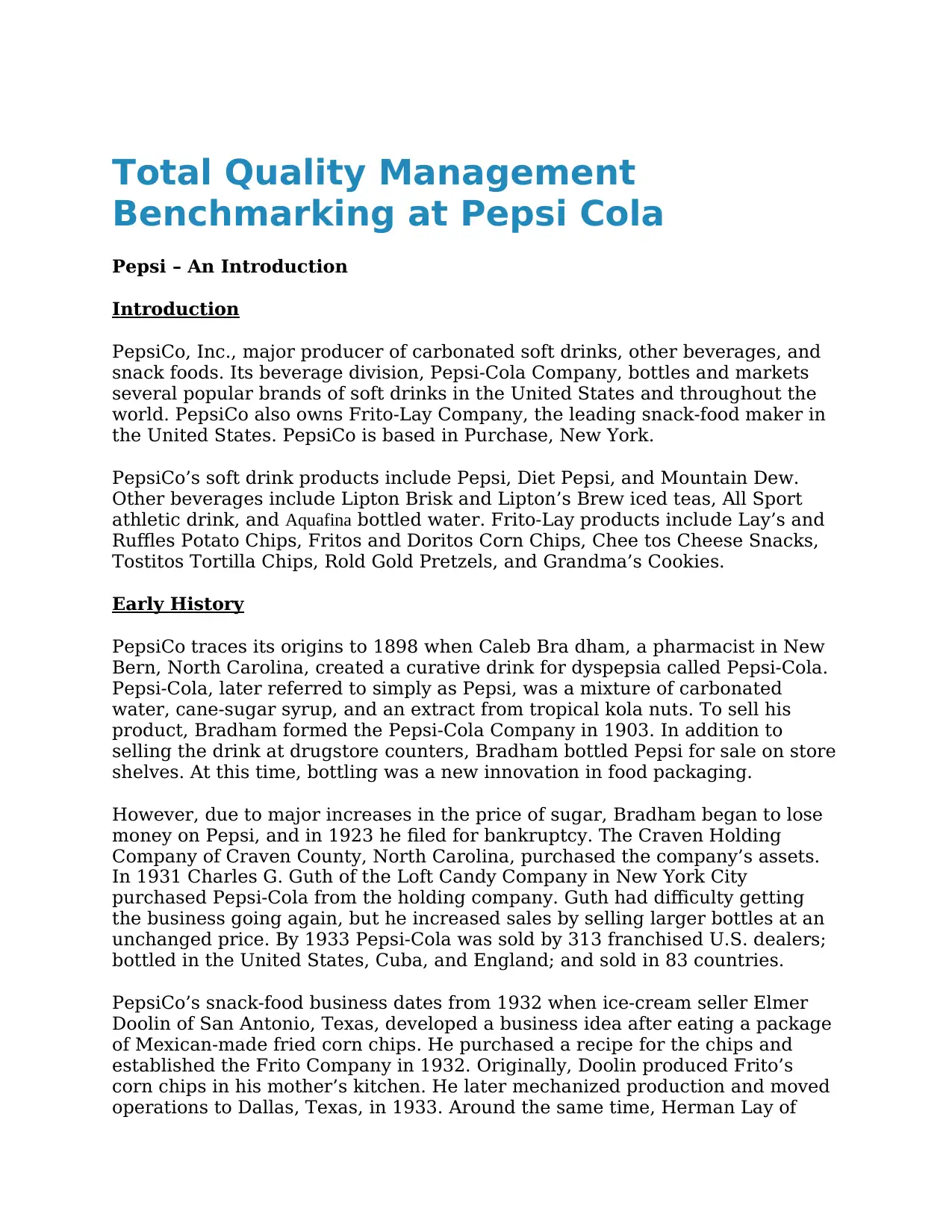
Total Quality Management
Benchmarking at Pepsi Cola
Pepsi – An Introduction
Introduction
PepsiCo, Inc., major producer of carbonated soft drinks, other beverages, and
snack foods. Its beverage division, Pepsi-Cola Company, bottles and markets
several popular brands of soft drinks in the United States and throughout the
world. PepsiCo also owns Frito-Lay Company, the leading snack-food maker in
the United States. PepsiCo is based in Purchase, New York.
PepsiCo’s soft drink products include Pepsi, Diet Pepsi, and Mountain Dew.
Other beverages include Lipton Brisk and Lipton’s Brew iced teas, All Sport
athletic drink, and Aquafina bottled water. Frito-Lay products include Lay’s and
Ruffles Potato Chips, Fritos and Doritos Corn Chips, Chee tos Cheese Snacks,
Tostitos Tortilla Chips, Rold Gold Pretzels, and Grandma’s Cookies.
Early History
PepsiCo traces its origins to 1898 when Caleb Bra dham, a pharmacist in New
Bern, North Carolina, created a curative drink for dyspepsia called Pepsi-Cola.
Pepsi-Cola, later referred to simply as Pepsi, was a mixture of carbonated
water, cane-sugar syrup, and an extract from tropical kola nuts. To sell his
product, Bradham formed the Pepsi-Cola Company in 1903. In addition to
selling the drink at drugstore counters, Bradham bottled Pepsi for sale on store
shelves. At this time, bottling was a new innovation in food packaging.
However, due to major increases in the price of sugar, Bradham began to lose
money on Pepsi, and in 1923 he filed for bankruptcy. The Craven Holding
Company of Craven County, North Carolina, purchased the company’s assets.
In 1931 Charles G. Guth of the Loft Candy Company in New York City
purchased Pepsi-Cola from the holding company. Guth had difficulty getting
the business going again, but he increased sales by selling larger bottles at an
unchanged price. By 1933 Pepsi-Cola was sold by 313 franchised U.S. dealers;
bottled in the United States, Cuba, and England; and sold in 83 countries.
PepsiCo’s snack-food business dates from 1932 when ice-cream seller Elmer
Doolin of San Antonio, Texas, developed a business idea after eating a package
of Mexican-made fried corn chips. He purchased a recipe for the chips and
established the Frito Company in 1932. Originally, Doolin produced Frito’s
corn chips in his mother’s kitchen. He later mechanized production and moved
operations to Dallas, Texas, in 1933. Around the same time, Herman Lay of
Benchmarking at Pepsi Cola
Pepsi – An Introduction
Introduction
PepsiCo, Inc., major producer of carbonated soft drinks, other beverages, and
snack foods. Its beverage division, Pepsi-Cola Company, bottles and markets
several popular brands of soft drinks in the United States and throughout the
world. PepsiCo also owns Frito-Lay Company, the leading snack-food maker in
the United States. PepsiCo is based in Purchase, New York.
PepsiCo’s soft drink products include Pepsi, Diet Pepsi, and Mountain Dew.
Other beverages include Lipton Brisk and Lipton’s Brew iced teas, All Sport
athletic drink, and Aquafina bottled water. Frito-Lay products include Lay’s and
Ruffles Potato Chips, Fritos and Doritos Corn Chips, Chee tos Cheese Snacks,
Tostitos Tortilla Chips, Rold Gold Pretzels, and Grandma’s Cookies.
Early History
PepsiCo traces its origins to 1898 when Caleb Bra dham, a pharmacist in New
Bern, North Carolina, created a curative drink for dyspepsia called Pepsi-Cola.
Pepsi-Cola, later referred to simply as Pepsi, was a mixture of carbonated
water, cane-sugar syrup, and an extract from tropical kola nuts. To sell his
product, Bradham formed the Pepsi-Cola Company in 1903. In addition to
selling the drink at drugstore counters, Bradham bottled Pepsi for sale on store
shelves. At this time, bottling was a new innovation in food packaging.
However, due to major increases in the price of sugar, Bradham began to lose
money on Pepsi, and in 1923 he filed for bankruptcy. The Craven Holding
Company of Craven County, North Carolina, purchased the company’s assets.
In 1931 Charles G. Guth of the Loft Candy Company in New York City
purchased Pepsi-Cola from the holding company. Guth had difficulty getting
the business going again, but he increased sales by selling larger bottles at an
unchanged price. By 1933 Pepsi-Cola was sold by 313 franchised U.S. dealers;
bottled in the United States, Cuba, and England; and sold in 83 countries.
PepsiCo’s snack-food business dates from 1932 when ice-cream seller Elmer
Doolin of San Antonio, Texas, developed a business idea after eating a package
of Mexican-made fried corn chips. He purchased a recipe for the chips and
established the Frito Company in 1932. Originally, Doolin produced Frito’s
corn chips in his mother’s kitchen. He later mechanized production and moved
operations to Dallas, Texas, in 1933. Around the same time, Herman Lay of
Secure Best Marks with AI Grader
Need help grading? Try our AI Grader for instant feedback on your assignments.

Nashville, Tennessee, developed a business distributing potato chips made by
an Atlanta manufacturer. In 1938 Lay bought the manufacturing company,
renaming it H. W. Lay & Company. The company prospered, becoming one of
the largest producers and distributors of snack foods in the southeastern
United States. The company made and sold many snack foods, but its best-
seller was its brand of potato chips, known as Lay’s. In 1945 the Frito Company
gave H. W. Lay & Company exclusive Southeast distribution rights for Frito’s
corn chips, a market both companies hoped to expand nationwide. After
continuing their close business association for over 15 years, the two
companies merged in 1961 to become Frito-Lay, Inc., with headquarters in
Texas.
Growth
The Pepsi-Cola Company, meanwhile, had changed hands several times and
grown greatly since 1933. The Loft Candy Company merged with the company
in 1941, keeping the Pepsi-Cola name. About this time, Pepsi became the
second-best selling soft drink in America behind its chief market rival, Coca-
Cola (popularly known as Coke). In 1948 the Pepsi-Cola Company began
canning drinks in addition to selling them in bottles. Alfred Steele, formerly an
executive with the Coca-Cola Company, became president of the Pepsi-Cola
Company in 1950. Former amateur boxer Donald Kendall took over as company
president and chief executive officer (CEO) in 1963 and began marketing Pepsi
to young people in an advertising campaign called “The Pepsi Generation.” The
company acquired another popular soft drink, Mountain Dew, in 1964. In 1965
the Pepsi-Cola Company merged with Frito-Lay, Inc., to become PepsiCo, Inc.,
based in New York City. As president and CEO of the newly merged company,
Kendall later moved the corporate headquarters to its current home in
Purchase, New York.
In 1972 PepsiCo struck a deal with the Union of Soviet Socialist Republics
(USSR), allowing the company to distribute Stolichnaya vodka in the United
States and to build soft-drink bottling facilities in the USSR. Pepsi thus became
one of the first American products to be made and sold in the Soviet Union. In
the late 1970s the company began to purchase fast-food chains. It acquired
Pizza Hut in 1977, Taco Bell in 1978, and Kentucky Fried Chicken (later named
KFC) in 1986.
The Cola wars
PepsiCo’s leading soft drink, Pepsi-Cola, and its chief rival, Coke, have
dominated the soft-drink market for decades, although Pepsi has traditionally
remained behind Coke. In 1950 Coke outsold Pepsi by 500 percent worldwide.
But Pepsi’s aggressive advertising campaigns aimed at young consumers and
major bottling and marketing deals made Pepsi a close rival to Coke by the
1980s. PepsiCo has also enjoyed great success with its canned and bottled
Lipton brand iced teas, earning higher sales than the Coca-Cola Company’s
Nestea products. Also, in the United States, Pepsi had virtually an even market
an Atlanta manufacturer. In 1938 Lay bought the manufacturing company,
renaming it H. W. Lay & Company. The company prospered, becoming one of
the largest producers and distributors of snack foods in the southeastern
United States. The company made and sold many snack foods, but its best-
seller was its brand of potato chips, known as Lay’s. In 1945 the Frito Company
gave H. W. Lay & Company exclusive Southeast distribution rights for Frito’s
corn chips, a market both companies hoped to expand nationwide. After
continuing their close business association for over 15 years, the two
companies merged in 1961 to become Frito-Lay, Inc., with headquarters in
Texas.
Growth
The Pepsi-Cola Company, meanwhile, had changed hands several times and
grown greatly since 1933. The Loft Candy Company merged with the company
in 1941, keeping the Pepsi-Cola name. About this time, Pepsi became the
second-best selling soft drink in America behind its chief market rival, Coca-
Cola (popularly known as Coke). In 1948 the Pepsi-Cola Company began
canning drinks in addition to selling them in bottles. Alfred Steele, formerly an
executive with the Coca-Cola Company, became president of the Pepsi-Cola
Company in 1950. Former amateur boxer Donald Kendall took over as company
president and chief executive officer (CEO) in 1963 and began marketing Pepsi
to young people in an advertising campaign called “The Pepsi Generation.” The
company acquired another popular soft drink, Mountain Dew, in 1964. In 1965
the Pepsi-Cola Company merged with Frito-Lay, Inc., to become PepsiCo, Inc.,
based in New York City. As president and CEO of the newly merged company,
Kendall later moved the corporate headquarters to its current home in
Purchase, New York.
In 1972 PepsiCo struck a deal with the Union of Soviet Socialist Republics
(USSR), allowing the company to distribute Stolichnaya vodka in the United
States and to build soft-drink bottling facilities in the USSR. Pepsi thus became
one of the first American products to be made and sold in the Soviet Union. In
the late 1970s the company began to purchase fast-food chains. It acquired
Pizza Hut in 1977, Taco Bell in 1978, and Kentucky Fried Chicken (later named
KFC) in 1986.
The Cola wars
PepsiCo’s leading soft drink, Pepsi-Cola, and its chief rival, Coke, have
dominated the soft-drink market for decades, although Pepsi has traditionally
remained behind Coke. In 1950 Coke outsold Pepsi by 500 percent worldwide.
But Pepsi’s aggressive advertising campaigns aimed at young consumers and
major bottling and marketing deals made Pepsi a close rival to Coke by the
1980s. PepsiCo has also enjoyed great success with its canned and bottled
Lipton brand iced teas, earning higher sales than the Coca-Cola Company’s
Nestea products. Also, in the United States, Pepsi had virtually an even market

share with Coke in the mid-1980s, when the Coca-Cola Company changed the
formula for Coke. (It later reintroduced the original formula under a new name,
Coke Classic.) However, as Coke regained popularity worldwide in the late
1980s and into the 1990s, it again became the global soft-drink leader. In 1996
Pepsi-Cola International, PepsiCo’s international beverage production and
marketing division, suffered difficulties in Latin America, one of its most
important markets. The company was particularly hurt by the loss of a bottling
plant to the Coca-Cola Company in Venezuela.
Snack food Market Dominance
Many of PepsiCo’s other products continued to dominate their markets in the
1990s. Sales of Frito-Lay products accounted for about 40 percent of PepsiCo’s
total profits. By the mid-1990s Frito-Lay products made up more than half of
the U.S. market for snack chips, and the company owned eight of the top ten
chip brands. In 1995 U.S. consumers bought the company’s original potato chip
brand, Lay’s, at a rate of 4.5 kg (10 lb) a second. The company’s leading
product, Dorito’s tortilla chips, was the best-selling salty snack (packaged) food
in America in the mid-1990s. Salty snack foods include chips, pretzels, and
nuts, as opposed to nonsalty snack foods such as cookies and cakes. In 1994
Frito-Lay began producing several baked and low-fat versions of some of their
snack foods—such as Baked Lays potato chips and Baked Tostitos tortilla chips
—which soon dominated the company’s sales growth.
Recent Developments
By the mid-1990s PepsiCo’s restaurant business consisted of 28,000 outlets
worldwide, more than were owned by any other company. The company also
supplied its own restaurants through a separate division, PepsiCo Food
Systems (PFS). In 1997 PepsiCo sold PFS. Also that year, PepsiCo spun off its
restaurant chains to form a new company. The move enabled PepsiCo to focus
on its beverages and snack foods. In 2001 PepsiCo acquired The Quaker Oats
Company, a food and Beverage Company.
Pepsi cola in Pakistan
In Pakistan, there have been consumed different types of soft drinks but Pepsi
is the most frequently consumed soft drink. It is very much popular in the
consumer; it has got big target market and is competing with the other
companies of soft drinks. 10 units of Pepsi cola have been installed, in the
different places of Pakistan i.e., Lahore, Multan, Gujranwala, etc., and working
with the best utilization of their resources in the optimum way. Each of these
units is owned by the different parties, which are strictly following the rules of
the parent company. The company to made production has licensed each unit.
These units have their own areas of selling and have different target markets.
All these units are considered as separate firms, which are the franchisees of
Pepsi cola international.
formula for Coke. (It later reintroduced the original formula under a new name,
Coke Classic.) However, as Coke regained popularity worldwide in the late
1980s and into the 1990s, it again became the global soft-drink leader. In 1996
Pepsi-Cola International, PepsiCo’s international beverage production and
marketing division, suffered difficulties in Latin America, one of its most
important markets. The company was particularly hurt by the loss of a bottling
plant to the Coca-Cola Company in Venezuela.
Snack food Market Dominance
Many of PepsiCo’s other products continued to dominate their markets in the
1990s. Sales of Frito-Lay products accounted for about 40 percent of PepsiCo’s
total profits. By the mid-1990s Frito-Lay products made up more than half of
the U.S. market for snack chips, and the company owned eight of the top ten
chip brands. In 1995 U.S. consumers bought the company’s original potato chip
brand, Lay’s, at a rate of 4.5 kg (10 lb) a second. The company’s leading
product, Dorito’s tortilla chips, was the best-selling salty snack (packaged) food
in America in the mid-1990s. Salty snack foods include chips, pretzels, and
nuts, as opposed to nonsalty snack foods such as cookies and cakes. In 1994
Frito-Lay began producing several baked and low-fat versions of some of their
snack foods—such as Baked Lays potato chips and Baked Tostitos tortilla chips
—which soon dominated the company’s sales growth.
Recent Developments
By the mid-1990s PepsiCo’s restaurant business consisted of 28,000 outlets
worldwide, more than were owned by any other company. The company also
supplied its own restaurants through a separate division, PepsiCo Food
Systems (PFS). In 1997 PepsiCo sold PFS. Also that year, PepsiCo spun off its
restaurant chains to form a new company. The move enabled PepsiCo to focus
on its beverages and snack foods. In 2001 PepsiCo acquired The Quaker Oats
Company, a food and Beverage Company.
Pepsi cola in Pakistan
In Pakistan, there have been consumed different types of soft drinks but Pepsi
is the most frequently consumed soft drink. It is very much popular in the
consumer; it has got big target market and is competing with the other
companies of soft drinks. 10 units of Pepsi cola have been installed, in the
different places of Pakistan i.e., Lahore, Multan, Gujranwala, etc., and working
with the best utilization of their resources in the optimum way. Each of these
units is owned by the different parties, which are strictly following the rules of
the parent company. The company to made production has licensed each unit.
These units have their own areas of selling and have different target markets.
All these units are considered as separate firms, which are the franchisees of
Pepsi cola international.
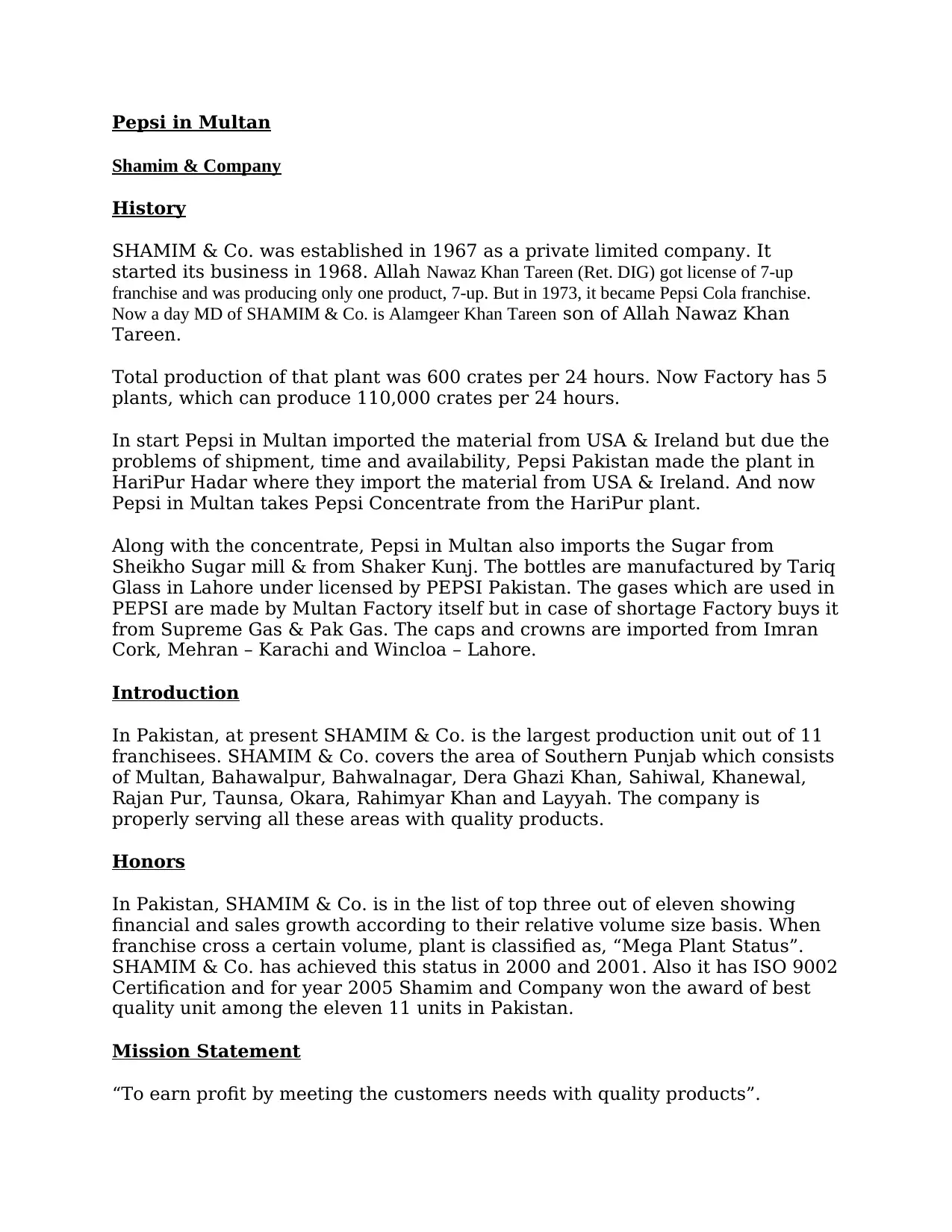
Pepsi in Multan
Shamim & Company
History
SHAMIM & Co. was established in 1967 as a private limited company. It
started its business in 1968. Allah Nawaz Khan Tareen (Ret. DIG) got license of 7-up
franchise and was producing only one product, 7-up. But in 1973, it became Pepsi Cola franchise.
Now a day MD of SHAMIM & Co. is Alamgeer Khan Tareen son of Allah Nawaz Khan
Tareen.
Total production of that plant was 600 crates per 24 hours. Now Factory has 5
plants, which can produce 110,000 crates per 24 hours.
In start Pepsi in Multan imported the material from USA & Ireland but due the
problems of shipment, time and availability, Pepsi Pakistan made the plant in
HariPur Hadar where they import the material from USA & Ireland. And now
Pepsi in Multan takes Pepsi Concentrate from the HariPur plant.
Along with the concentrate, Pepsi in Multan also imports the Sugar from
Sheikho Sugar mill & from Shaker Kunj. The bottles are manufactured by Tariq
Glass in Lahore under licensed by PEPSI Pakistan. The gases which are used in
PEPSI are made by Multan Factory itself but in case of shortage Factory buys it
from Supreme Gas & Pak Gas. The caps and crowns are imported from Imran
Cork, Mehran – Karachi and Wincloa – Lahore.
Introduction
In Pakistan, at present SHAMIM & Co. is the largest production unit out of 11
franchisees. SHAMIM & Co. covers the area of Southern Punjab which consists
of Multan, Bahawalpur, Bahwalnagar, Dera Ghazi Khan, Sahiwal, Khanewal,
Rajan Pur, Taunsa, Okara, Rahimyar Khan and Layyah. The company is
properly serving all these areas with quality products.
Honors
In Pakistan, SHAMIM & Co. is in the list of top three out of eleven showing
financial and sales growth according to their relative volume size basis. When
franchise cross a certain volume, plant is classified as, “Mega Plant Status”.
SHAMIM & Co. has achieved this status in 2000 and 2001. Also it has ISO 9002
Certification and for year 2005 Shamim and Company won the award of best
quality unit among the eleven 11 units in Pakistan.
Mission Statement
“To earn profit by meeting the customers needs with quality products”.
Shamim & Company
History
SHAMIM & Co. was established in 1967 as a private limited company. It
started its business in 1968. Allah Nawaz Khan Tareen (Ret. DIG) got license of 7-up
franchise and was producing only one product, 7-up. But in 1973, it became Pepsi Cola franchise.
Now a day MD of SHAMIM & Co. is Alamgeer Khan Tareen son of Allah Nawaz Khan
Tareen.
Total production of that plant was 600 crates per 24 hours. Now Factory has 5
plants, which can produce 110,000 crates per 24 hours.
In start Pepsi in Multan imported the material from USA & Ireland but due the
problems of shipment, time and availability, Pepsi Pakistan made the plant in
HariPur Hadar where they import the material from USA & Ireland. And now
Pepsi in Multan takes Pepsi Concentrate from the HariPur plant.
Along with the concentrate, Pepsi in Multan also imports the Sugar from
Sheikho Sugar mill & from Shaker Kunj. The bottles are manufactured by Tariq
Glass in Lahore under licensed by PEPSI Pakistan. The gases which are used in
PEPSI are made by Multan Factory itself but in case of shortage Factory buys it
from Supreme Gas & Pak Gas. The caps and crowns are imported from Imran
Cork, Mehran – Karachi and Wincloa – Lahore.
Introduction
In Pakistan, at present SHAMIM & Co. is the largest production unit out of 11
franchisees. SHAMIM & Co. covers the area of Southern Punjab which consists
of Multan, Bahawalpur, Bahwalnagar, Dera Ghazi Khan, Sahiwal, Khanewal,
Rajan Pur, Taunsa, Okara, Rahimyar Khan and Layyah. The company is
properly serving all these areas with quality products.
Honors
In Pakistan, SHAMIM & Co. is in the list of top three out of eleven showing
financial and sales growth according to their relative volume size basis. When
franchise cross a certain volume, plant is classified as, “Mega Plant Status”.
SHAMIM & Co. has achieved this status in 2000 and 2001. Also it has ISO 9002
Certification and for year 2005 Shamim and Company won the award of best
quality unit among the eleven 11 units in Pakistan.
Mission Statement
“To earn profit by meeting the customers needs with quality products”.
Secure Best Marks with AI Grader
Need help grading? Try our AI Grader for instant feedback on your assignments.
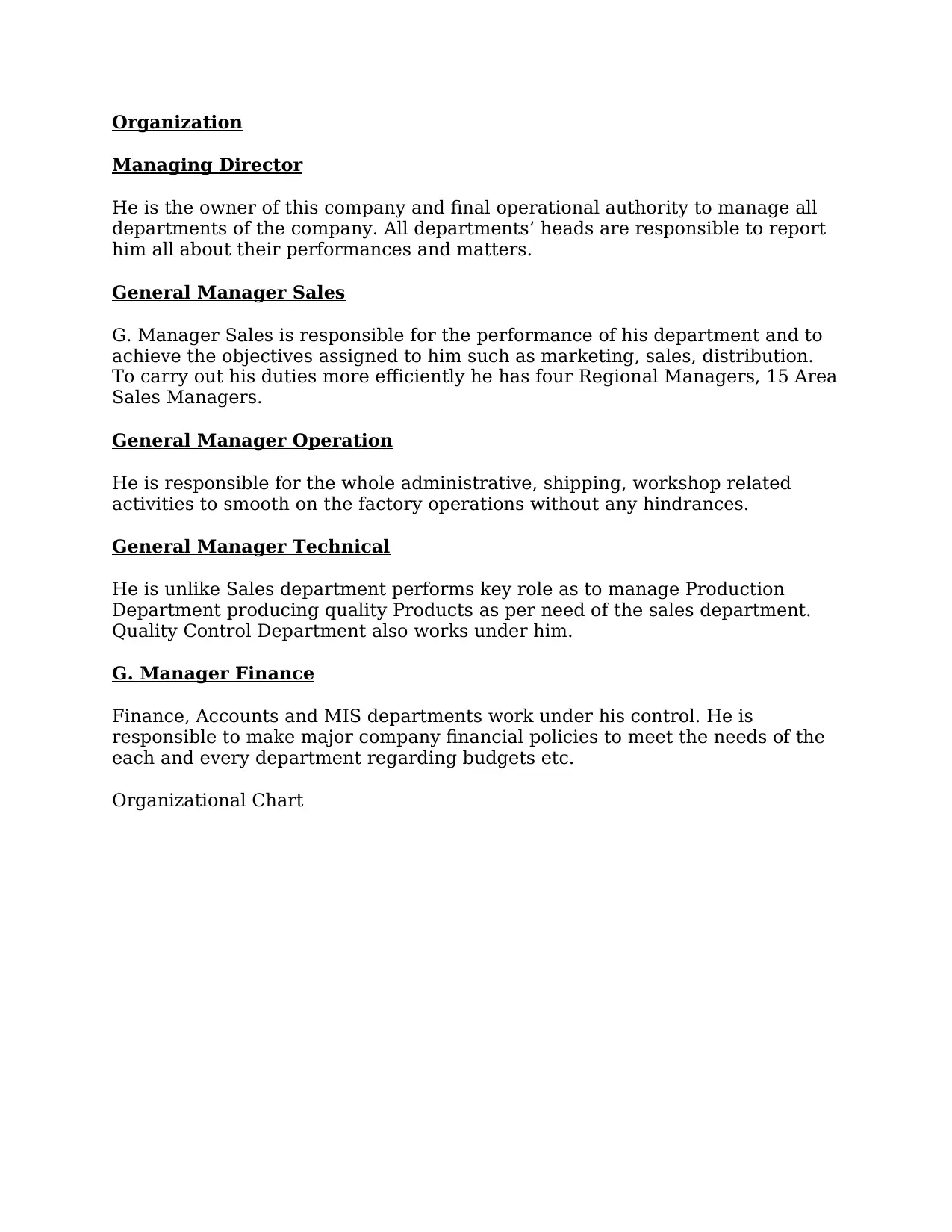
Organization
Managing Director
He is the owner of this company and final operational authority to manage all
departments of the company. All departments’ heads are responsible to report
him all about their performances and matters.
General Manager Sales
G. Manager Sales is responsible for the performance of his department and to
achieve the objectives assigned to him such as marketing, sales, distribution.
To carry out his duties more efficiently he has four Regional Managers, 15 Area
Sales Managers.
General Manager Operation
He is responsible for the whole administrative, shipping, workshop related
activities to smooth on the factory operations without any hindrances.
General Manager Technical
He is unlike Sales department performs key role as to manage Production
Department producing quality Products as per need of the sales department.
Quality Control Department also works under him.
G. Manager Finance
Finance, Accounts and MIS departments work under his control. He is
responsible to make major company financial policies to meet the needs of the
each and every department regarding budgets etc.
Organizational Chart
Managing Director
He is the owner of this company and final operational authority to manage all
departments of the company. All departments’ heads are responsible to report
him all about their performances and matters.
General Manager Sales
G. Manager Sales is responsible for the performance of his department and to
achieve the objectives assigned to him such as marketing, sales, distribution.
To carry out his duties more efficiently he has four Regional Managers, 15 Area
Sales Managers.
General Manager Operation
He is responsible for the whole administrative, shipping, workshop related
activities to smooth on the factory operations without any hindrances.
General Manager Technical
He is unlike Sales department performs key role as to manage Production
Department producing quality Products as per need of the sales department.
Quality Control Department also works under him.
G. Manager Finance
Finance, Accounts and MIS departments work under his control. He is
responsible to make major company financial policies to meet the needs of the
each and every department regarding budgets etc.
Organizational Chart

Global strategy
Pepsi has divided the total international market on the basis of taste
constituting into three zones.
Asian zone
European zone
African zone
Pepsi is using the licensing strategy to go abroad. SHAMIM & Co. is also a
Licensee.
Competitive priorities
“The competitive priorities are the operating advantages that firm’s processes
must possess to outperform its competitors.”
Shamim & Co. has the competitive priorities of high-performance design and
consistent quality.
High-Performance design
Actually Pepsi is getting the competitive edge in our region on the basis of its
quality and the quality is its taste. Through a complete marketing research they
found that sweet taste is liked more by this region. That’s why in Pakistan
Pepsi is dominant soft drink and it has almost 75% shares in this market. On
the other hand when we look internationality then Coca Cola is the leading
company. So Pakistan is a big market for the Pepsi, where Pepsi is generating a
lot of revenues.
Pepsi has divided the total international market on the basis of taste
constituting into three zones.
Asian zone
European zone
African zone
Pepsi is using the licensing strategy to go abroad. SHAMIM & Co. is also a
Licensee.
Competitive priorities
“The competitive priorities are the operating advantages that firm’s processes
must possess to outperform its competitors.”
Shamim & Co. has the competitive priorities of high-performance design and
consistent quality.
High-Performance design
Actually Pepsi is getting the competitive edge in our region on the basis of its
quality and the quality is its taste. Through a complete marketing research they
found that sweet taste is liked more by this region. That’s why in Pakistan
Pepsi is dominant soft drink and it has almost 75% shares in this market. On
the other hand when we look internationality then Coca Cola is the leading
company. So Pakistan is a big market for the Pepsi, where Pepsi is generating a
lot of revenues.
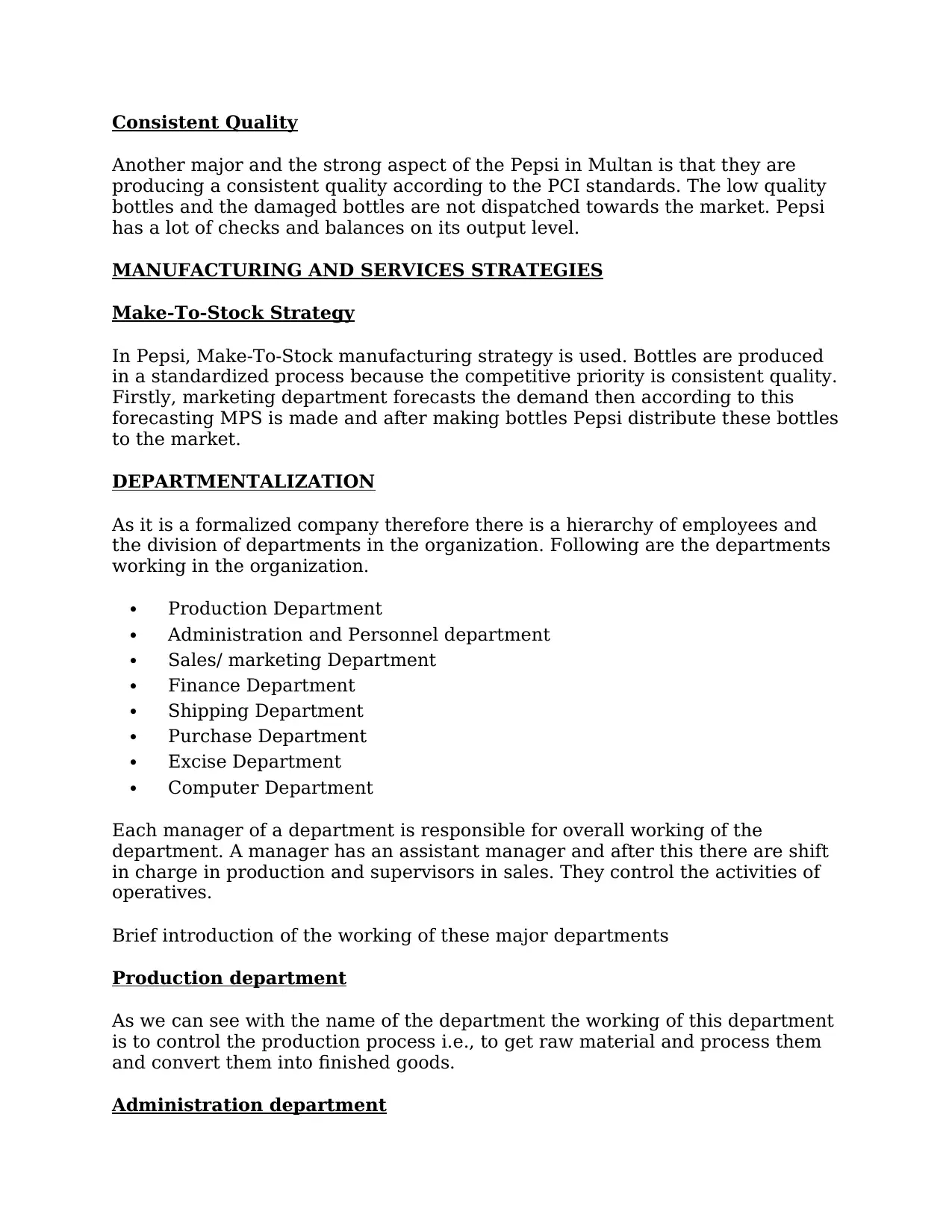
Consistent Quality
Another major and the strong aspect of the Pepsi in Multan is that they are
producing a consistent quality according to the PCI standards. The low quality
bottles and the damaged bottles are not dispatched towards the market. Pepsi
has a lot of checks and balances on its output level.
MANUFACTURING AND SERVICES STRATEGIES
Make-To-Stock Strategy
In Pepsi, Make-To-Stock manufacturing strategy is used. Bottles are produced
in a standardized process because the competitive priority is consistent quality.
Firstly, marketing department forecasts the demand then according to this
forecasting MPS is made and after making bottles Pepsi distribute these bottles
to the market.
DEPARTMENTALIZATION
As it is a formalized company therefore there is a hierarchy of employees and
the division of departments in the organization. Following are the departments
working in the organization.
Production Department
Administration and Personnel department
Sales/ marketing Department
Finance Department
Shipping Department
Purchase Department
Excise Department
Computer Department
Each manager of a department is responsible for overall working of the
department. A manager has an assistant manager and after this there are shift
in charge in production and supervisors in sales. They control the activities of
operatives.
Brief introduction of the working of these major departments
Production department
As we can see with the name of the department the working of this department
is to control the production process i.e., to get raw material and process them
and convert them into finished goods.
Administration department
Another major and the strong aspect of the Pepsi in Multan is that they are
producing a consistent quality according to the PCI standards. The low quality
bottles and the damaged bottles are not dispatched towards the market. Pepsi
has a lot of checks and balances on its output level.
MANUFACTURING AND SERVICES STRATEGIES
Make-To-Stock Strategy
In Pepsi, Make-To-Stock manufacturing strategy is used. Bottles are produced
in a standardized process because the competitive priority is consistent quality.
Firstly, marketing department forecasts the demand then according to this
forecasting MPS is made and after making bottles Pepsi distribute these bottles
to the market.
DEPARTMENTALIZATION
As it is a formalized company therefore there is a hierarchy of employees and
the division of departments in the organization. Following are the departments
working in the organization.
Production Department
Administration and Personnel department
Sales/ marketing Department
Finance Department
Shipping Department
Purchase Department
Excise Department
Computer Department
Each manager of a department is responsible for overall working of the
department. A manager has an assistant manager and after this there are shift
in charge in production and supervisors in sales. They control the activities of
operatives.
Brief introduction of the working of these major departments
Production department
As we can see with the name of the department the working of this department
is to control the production process i.e., to get raw material and process them
and convert them into finished goods.
Administration department
Paraphrase This Document
Need a fresh take? Get an instant paraphrase of this document with our AI Paraphraser
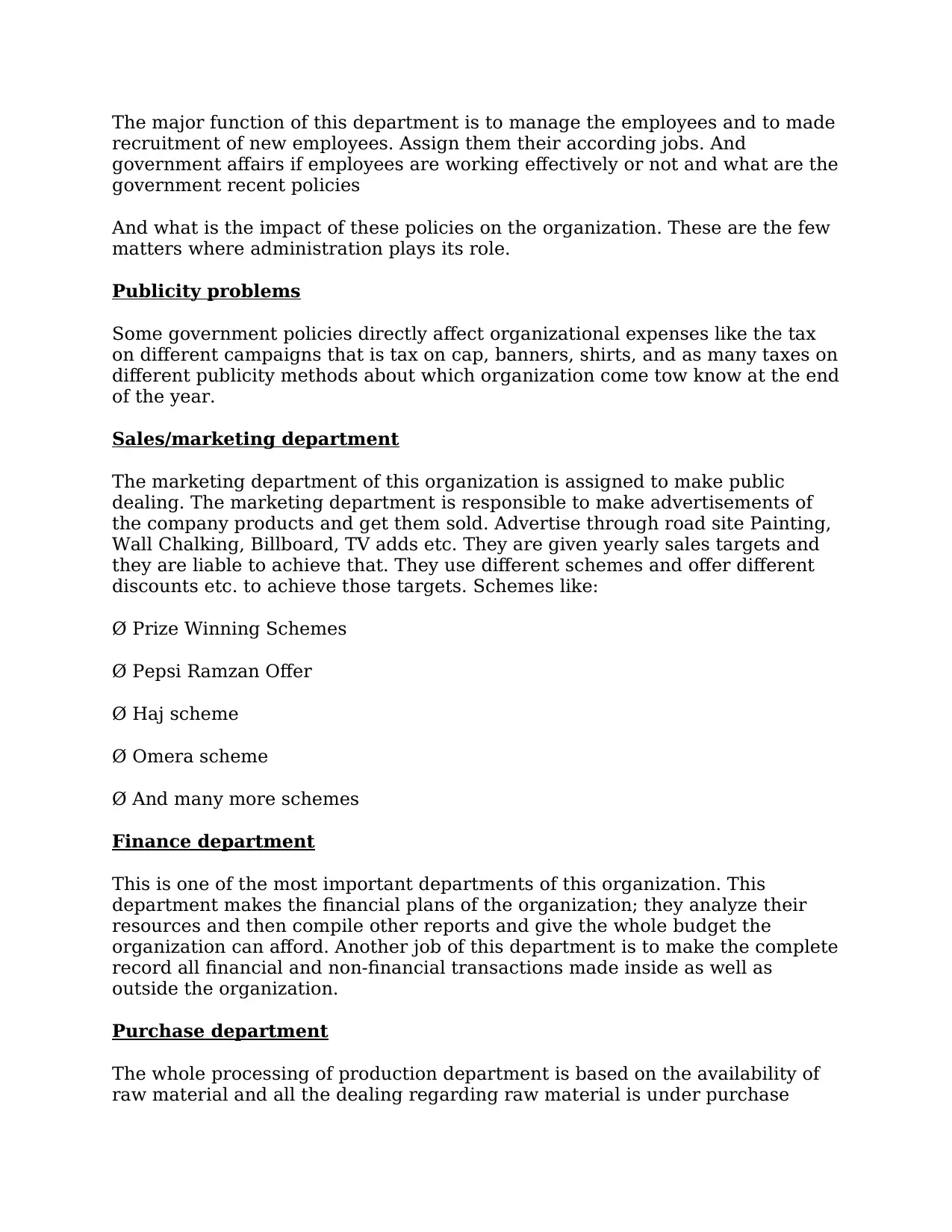
The major function of this department is to manage the employees and to made
recruitment of new employees. Assign them their according jobs. And
government affairs if employees are working effectively or not and what are the
government recent policies
And what is the impact of these policies on the organization. These are the few
matters where administration plays its role.
Publicity problems
Some government policies directly affect organizational expenses like the tax
on different campaigns that is tax on cap, banners, shirts, and as many taxes on
different publicity methods about which organization come tow know at the end
of the year.
Sales/marketing department
The marketing department of this organization is assigned to make public
dealing. The marketing department is responsible to make advertisements of
the company products and get them sold. Advertise through road site Painting,
Wall Chalking, Billboard, TV adds etc. They are given yearly sales targets and
they are liable to achieve that. They use different schemes and offer different
discounts etc. to achieve those targets. Schemes like:
Ø Prize Winning Schemes
Ø Pepsi Ramzan Offer
Ø Haj scheme
Ø Omera scheme
Ø And many more schemes
Finance department
This is one of the most important departments of this organization. This
department makes the financial plans of the organization; they analyze their
resources and then compile other reports and give the whole budget the
organization can afford. Another job of this department is to make the complete
record all financial and non-financial transactions made inside as well as
outside the organization.
Purchase department
The whole processing of production department is based on the availability of
raw material and all the dealing regarding raw material is under purchase
recruitment of new employees. Assign them their according jobs. And
government affairs if employees are working effectively or not and what are the
government recent policies
And what is the impact of these policies on the organization. These are the few
matters where administration plays its role.
Publicity problems
Some government policies directly affect organizational expenses like the tax
on different campaigns that is tax on cap, banners, shirts, and as many taxes on
different publicity methods about which organization come tow know at the end
of the year.
Sales/marketing department
The marketing department of this organization is assigned to make public
dealing. The marketing department is responsible to make advertisements of
the company products and get them sold. Advertise through road site Painting,
Wall Chalking, Billboard, TV adds etc. They are given yearly sales targets and
they are liable to achieve that. They use different schemes and offer different
discounts etc. to achieve those targets. Schemes like:
Ø Prize Winning Schemes
Ø Pepsi Ramzan Offer
Ø Haj scheme
Ø Omera scheme
Ø And many more schemes
Finance department
This is one of the most important departments of this organization. This
department makes the financial plans of the organization; they analyze their
resources and then compile other reports and give the whole budget the
organization can afford. Another job of this department is to make the complete
record all financial and non-financial transactions made inside as well as
outside the organization.
Purchase department
The whole processing of production department is based on the availability of
raw material and all the dealing regarding raw material is under purchase
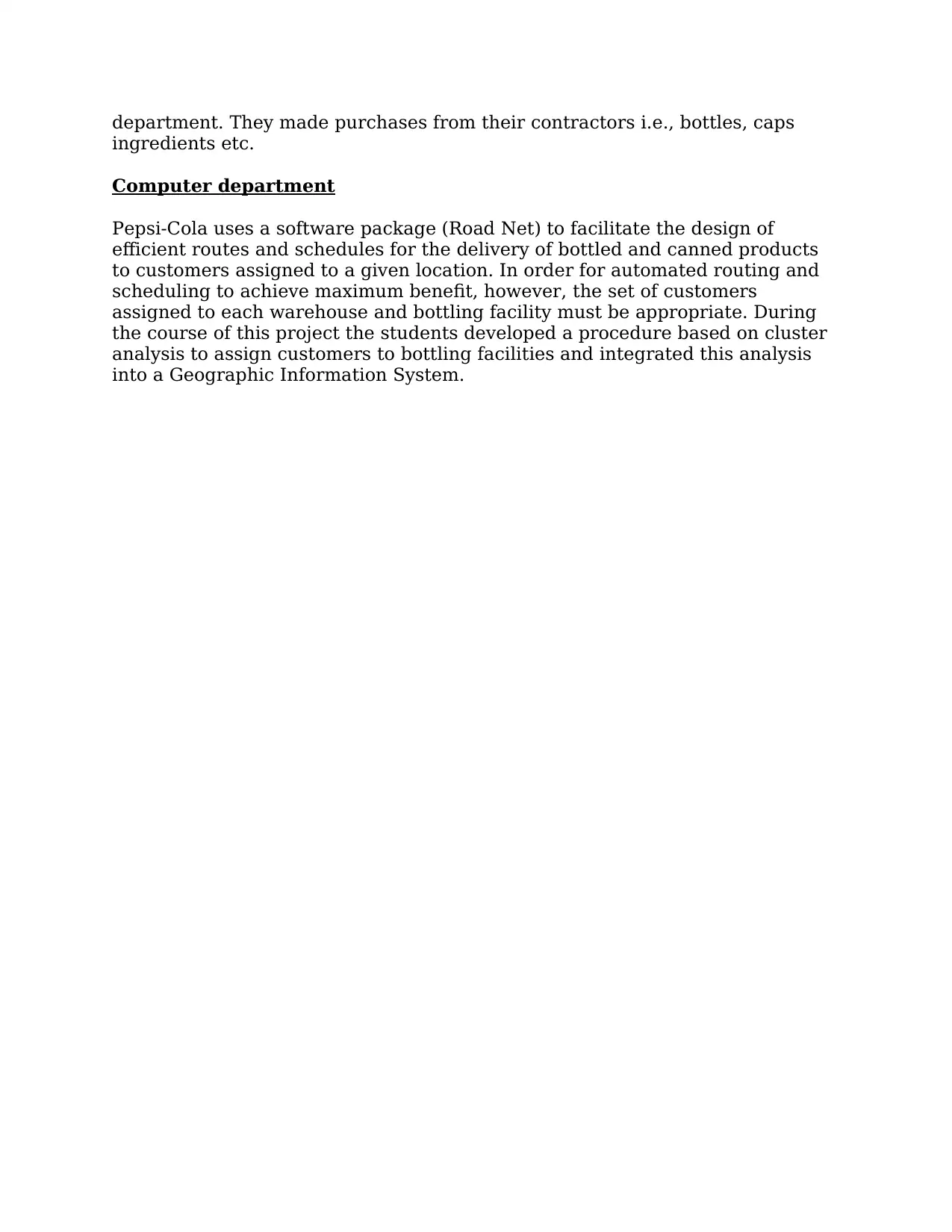
department. They made purchases from their contractors i.e., bottles, caps
ingredients etc.
Computer department
Pepsi-Cola uses a software package (Road Net) to facilitate the design of
efficient routes and schedules for the delivery of bottled and canned products
to customers assigned to a given location. In order for automated routing and
scheduling to achieve maximum benefit, however, the set of customers
assigned to each warehouse and bottling facility must be appropriate. During
the course of this project the students developed a procedure based on cluster
analysis to assign customers to bottling facilities and integrated this analysis
into a Geographic Information System.
ingredients etc.
Computer department
Pepsi-Cola uses a software package (Road Net) to facilitate the design of
efficient routes and schedules for the delivery of bottled and canned products
to customers assigned to a given location. In order for automated routing and
scheduling to achieve maximum benefit, however, the set of customers
assigned to each warehouse and bottling facility must be appropriate. During
the course of this project the students developed a procedure based on cluster
analysis to assign customers to bottling facilities and integrated this analysis
into a Geographic Information System.
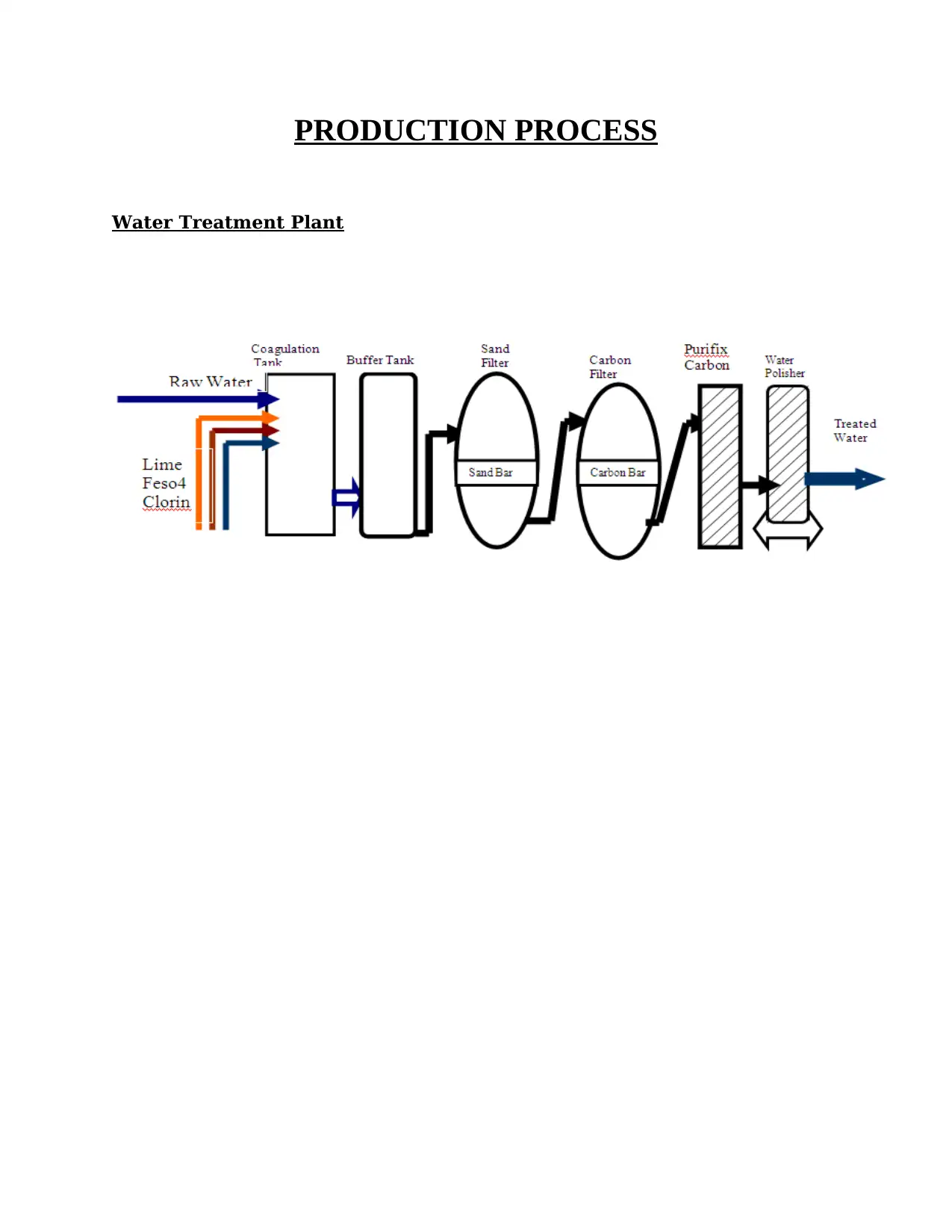
PRODUCTION PROCESS
Water Treatment Plant
Water Treatment Plant
Secure Best Marks with AI Grader
Need help grading? Try our AI Grader for instant feedback on your assignments.

Pepsi Bottles Filling Process
Purchasing and washing of bottles
Purchasing and washing of bottles
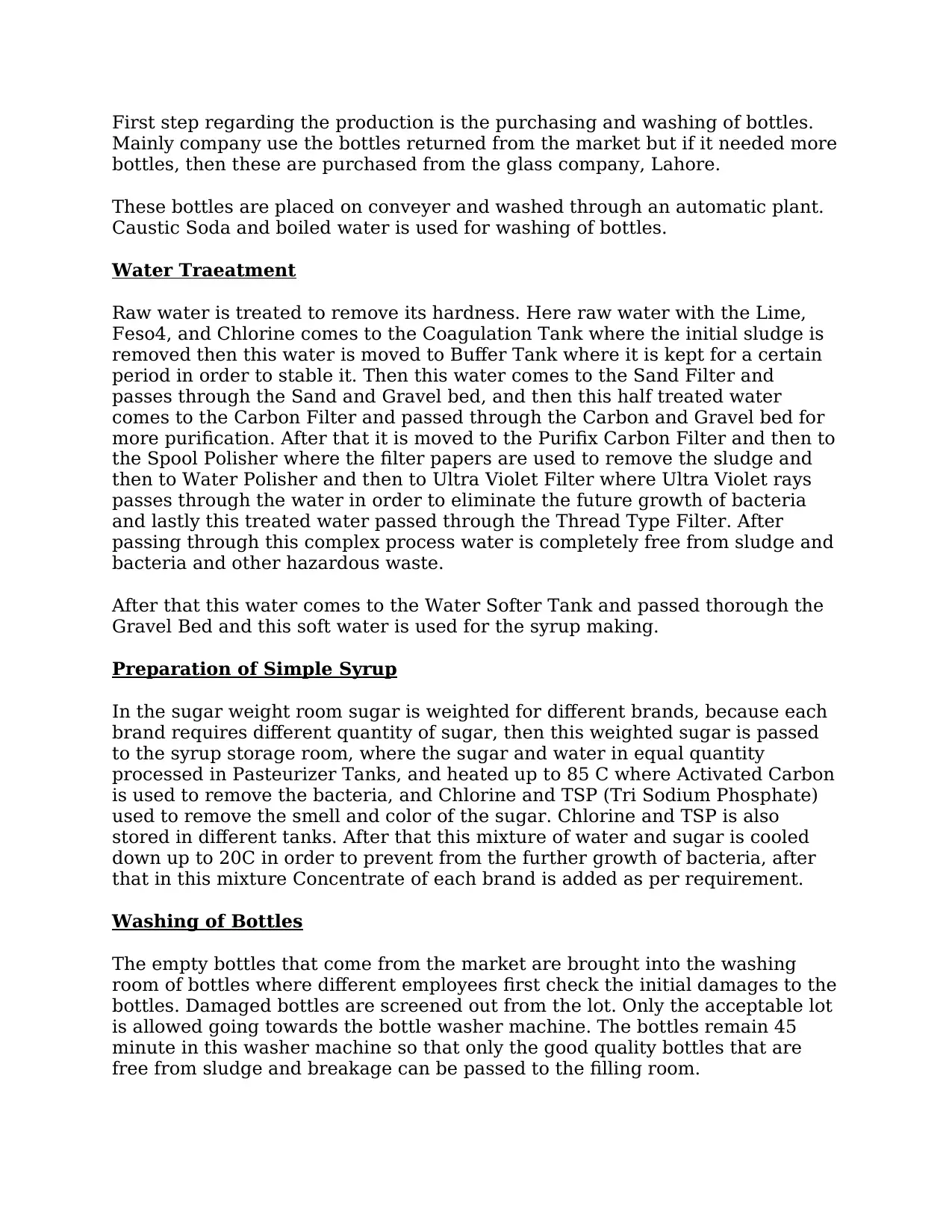
First step regarding the production is the purchasing and washing of bottles.
Mainly company use the bottles returned from the market but if it needed more
bottles, then these are purchased from the glass company, Lahore.
These bottles are placed on conveyer and washed through an automatic plant.
Caustic Soda and boiled water is used for washing of bottles.
Water Traeatment
Raw water is treated to remove its hardness. Here raw water with the Lime,
Feso4, and Chlorine comes to the Coagulation Tank where the initial sludge is
removed then this water is moved to Buffer Tank where it is kept for a certain
period in order to stable it. Then this water comes to the Sand Filter and
passes through the Sand and Gravel bed, and then this half treated water
comes to the Carbon Filter and passed through the Carbon and Gravel bed for
more purification. After that it is moved to the Purifix Carbon Filter and then to
the Spool Polisher where the filter papers are used to remove the sludge and
then to Water Polisher and then to Ultra Violet Filter where Ultra Violet rays
passes through the water in order to eliminate the future growth of bacteria
and lastly this treated water passed through the Thread Type Filter. After
passing through this complex process water is completely free from sludge and
bacteria and other hazardous waste.
After that this water comes to the Water Softer Tank and passed thorough the
Gravel Bed and this soft water is used for the syrup making.
Preparation of Simple Syrup
In the sugar weight room sugar is weighted for different brands, because each
brand requires different quantity of sugar, then this weighted sugar is passed
to the syrup storage room, where the sugar and water in equal quantity
processed in Pasteurizer Tanks, and heated up to 85 C where Activated Carbon
is used to remove the bacteria, and Chlorine and TSP (Tri Sodium Phosphate)
used to remove the smell and color of the sugar. Chlorine and TSP is also
stored in different tanks. After that this mixture of water and sugar is cooled
down up to 20C in order to prevent from the further growth of bacteria, after
that in this mixture Concentrate of each brand is added as per requirement.
Washing of Bottles
The empty bottles that come from the market are brought into the washing
room of bottles where different employees first check the initial damages to the
bottles. Damaged bottles are screened out from the lot. Only the acceptable lot
is allowed going towards the bottle washer machine. The bottles remain 45
minute in this washer machine so that only the good quality bottles that are
free from sludge and breakage can be passed to the filling room.
Mainly company use the bottles returned from the market but if it needed more
bottles, then these are purchased from the glass company, Lahore.
These bottles are placed on conveyer and washed through an automatic plant.
Caustic Soda and boiled water is used for washing of bottles.
Water Traeatment
Raw water is treated to remove its hardness. Here raw water with the Lime,
Feso4, and Chlorine comes to the Coagulation Tank where the initial sludge is
removed then this water is moved to Buffer Tank where it is kept for a certain
period in order to stable it. Then this water comes to the Sand Filter and
passes through the Sand and Gravel bed, and then this half treated water
comes to the Carbon Filter and passed through the Carbon and Gravel bed for
more purification. After that it is moved to the Purifix Carbon Filter and then to
the Spool Polisher where the filter papers are used to remove the sludge and
then to Water Polisher and then to Ultra Violet Filter where Ultra Violet rays
passes through the water in order to eliminate the future growth of bacteria
and lastly this treated water passed through the Thread Type Filter. After
passing through this complex process water is completely free from sludge and
bacteria and other hazardous waste.
After that this water comes to the Water Softer Tank and passed thorough the
Gravel Bed and this soft water is used for the syrup making.
Preparation of Simple Syrup
In the sugar weight room sugar is weighted for different brands, because each
brand requires different quantity of sugar, then this weighted sugar is passed
to the syrup storage room, where the sugar and water in equal quantity
processed in Pasteurizer Tanks, and heated up to 85 C where Activated Carbon
is used to remove the bacteria, and Chlorine and TSP (Tri Sodium Phosphate)
used to remove the smell and color of the sugar. Chlorine and TSP is also
stored in different tanks. After that this mixture of water and sugar is cooled
down up to 20C in order to prevent from the further growth of bacteria, after
that in this mixture Concentrate of each brand is added as per requirement.
Washing of Bottles
The empty bottles that come from the market are brought into the washing
room of bottles where different employees first check the initial damages to the
bottles. Damaged bottles are screened out from the lot. Only the acceptable lot
is allowed going towards the bottle washer machine. The bottles remain 45
minute in this washer machine so that only the good quality bottles that are
free from sludge and breakage can be passed to the filling room.

Filling of Bottles
Mixing of CO2 Gas in Syrup
Syrup is sent to carbon coolers, Ammonia, Carbon Powder and Carbon
Granular are mixed in the syrup.
In the filling room the syrup and CO2 comes from syrup and CO2 room. From
Carbon cooler syrup goes to the filler and from other side empty bottles and
then crown cock or cap cocks are fixed on the bottles. Here operator looks
after the production process.
Filled bottles are then passed thorough light room where quality of bottles is
checked. Here under filled or, over filled bottles or dirty bottles are separated.
There are two light rooms and in each room one employee is placed to trace
out the dirty bottles.
After passing through light room the code is printed on the bottles, which
contain the manufacturing date, machine number and time of manufacturing
and the batch number.
After all this checking process bottles are placed in the crates. The whole
process of production is automatic. Only supervision is required. Then these
crates are sent to the output warehouse.
QUALITY CONTROL
It has become crystal clear that high quality products have a distinct advantage
in the market place, that market share can be gained or lost over the quality
issue. Therefore quality is a competitive priority.
Quality is important due to the following reasons:
• Cost and market share
• Company’s reputation
• Product liability
• International implications
Mixing of CO2 Gas in Syrup
Syrup is sent to carbon coolers, Ammonia, Carbon Powder and Carbon
Granular are mixed in the syrup.
In the filling room the syrup and CO2 comes from syrup and CO2 room. From
Carbon cooler syrup goes to the filler and from other side empty bottles and
then crown cock or cap cocks are fixed on the bottles. Here operator looks
after the production process.
Filled bottles are then passed thorough light room where quality of bottles is
checked. Here under filled or, over filled bottles or dirty bottles are separated.
There are two light rooms and in each room one employee is placed to trace
out the dirty bottles.
After passing through light room the code is printed on the bottles, which
contain the manufacturing date, machine number and time of manufacturing
and the batch number.
After all this checking process bottles are placed in the crates. The whole
process of production is automatic. Only supervision is required. Then these
crates are sent to the output warehouse.
QUALITY CONTROL
It has become crystal clear that high quality products have a distinct advantage
in the market place, that market share can be gained or lost over the quality
issue. Therefore quality is a competitive priority.
Quality is important due to the following reasons:
• Cost and market share
• Company’s reputation
• Product liability
• International implications
Paraphrase This Document
Need a fresh take? Get an instant paraphrase of this document with our AI Paraphraser

SHAMIM & COMPANY (PVT) LTD takes effective measures for the quality
control. Production of the company is according to the standards set by PCI. So
the company is very much concerned about quality. Quality of raw material as
well as of end product is checked.
Following are the main steps taken by the company for quality control.
Testing of Raw Material
Raw material used in production, comprises of the following items.
• Concentrate
• Sugar
• Treated Water
• Empty Bottles
• Carbon Dioxide
• Crown
From the above items, previously the franchiser from USA provided
concentrate. Now it has plant at Haripur and SHAMIM & COMPANY (PVT) LTD
purchase the concentrate from there. Because the franchiser provides
concentrate, so there is no question about its quality. All other raw material
purchased by the company itself.
Sugar Testing
The company from sugar mills purchases sugar. After the arrival of sugar at the
plant, it has to pass through a strict quality check. It should be free from
moisture.
First of all supervisor checks the quality of sugar. After this checking, a
randomly selected sample from sugar bag is sent to laboratory for testing. After
this testing, if the quality of sugar is according to the standards, then this
sugar is stored for further processing. If the sugar quality is not up to the
mark, then it is sent back to the sugar mill.
Water Treatment Testing
The company has four containers to meet the requirement of water. The water
is treated for the use in final processing. At different stages, different
treatment tests are done.
control. Production of the company is according to the standards set by PCI. So
the company is very much concerned about quality. Quality of raw material as
well as of end product is checked.
Following are the main steps taken by the company for quality control.
Testing of Raw Material
Raw material used in production, comprises of the following items.
• Concentrate
• Sugar
• Treated Water
• Empty Bottles
• Carbon Dioxide
• Crown
From the above items, previously the franchiser from USA provided
concentrate. Now it has plant at Haripur and SHAMIM & COMPANY (PVT) LTD
purchase the concentrate from there. Because the franchiser provides
concentrate, so there is no question about its quality. All other raw material
purchased by the company itself.
Sugar Testing
The company from sugar mills purchases sugar. After the arrival of sugar at the
plant, it has to pass through a strict quality check. It should be free from
moisture.
First of all supervisor checks the quality of sugar. After this checking, a
randomly selected sample from sugar bag is sent to laboratory for testing. After
this testing, if the quality of sugar is according to the standards, then this
sugar is stored for further processing. If the sugar quality is not up to the
mark, then it is sent back to the sugar mill.
Water Treatment Testing
The company has four containers to meet the requirement of water. The water
is treated for the use in final processing. At different stages, different
treatment tests are done.
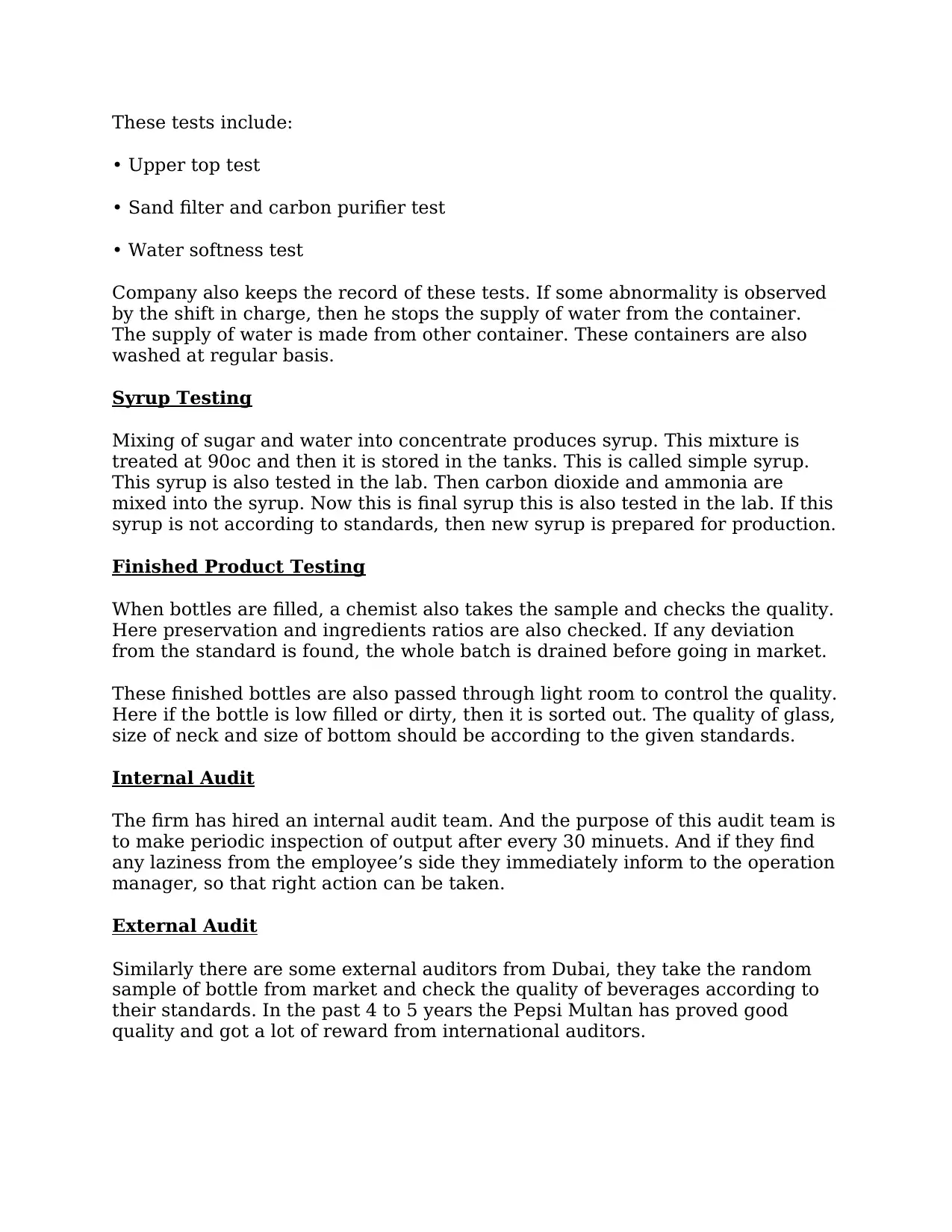
These tests include:
• Upper top test
• Sand filter and carbon purifier test
• Water softness test
Company also keeps the record of these tests. If some abnormality is observed
by the shift in charge, then he stops the supply of water from the container.
The supply of water is made from other container. These containers are also
washed at regular basis.
Syrup Testing
Mixing of sugar and water into concentrate produces syrup. This mixture is
treated at 90oc and then it is stored in the tanks. This is called simple syrup.
This syrup is also tested in the lab. Then carbon dioxide and ammonia are
mixed into the syrup. Now this is final syrup this is also tested in the lab. If this
syrup is not according to standards, then new syrup is prepared for production.
Finished Product Testing
When bottles are filled, a chemist also takes the sample and checks the quality.
Here preservation and ingredients ratios are also checked. If any deviation
from the standard is found, the whole batch is drained before going in market.
These finished bottles are also passed through light room to control the quality.
Here if the bottle is low filled or dirty, then it is sorted out. The quality of glass,
size of neck and size of bottom should be according to the given standards.
Internal Audit
The firm has hired an internal audit team. And the purpose of this audit team is
to make periodic inspection of output after every 30 minuets. And if they find
any laziness from the employee’s side they immediately inform to the operation
manager, so that right action can be taken.
External Audit
Similarly there are some external auditors from Dubai, they take the random
sample of bottle from market and check the quality of beverages according to
their standards. In the past 4 to 5 years the Pepsi Multan has proved good
quality and got a lot of reward from international auditors.
• Upper top test
• Sand filter and carbon purifier test
• Water softness test
Company also keeps the record of these tests. If some abnormality is observed
by the shift in charge, then he stops the supply of water from the container.
The supply of water is made from other container. These containers are also
washed at regular basis.
Syrup Testing
Mixing of sugar and water into concentrate produces syrup. This mixture is
treated at 90oc and then it is stored in the tanks. This is called simple syrup.
This syrup is also tested in the lab. Then carbon dioxide and ammonia are
mixed into the syrup. Now this is final syrup this is also tested in the lab. If this
syrup is not according to standards, then new syrup is prepared for production.
Finished Product Testing
When bottles are filled, a chemist also takes the sample and checks the quality.
Here preservation and ingredients ratios are also checked. If any deviation
from the standard is found, the whole batch is drained before going in market.
These finished bottles are also passed through light room to control the quality.
Here if the bottle is low filled or dirty, then it is sorted out. The quality of glass,
size of neck and size of bottom should be according to the given standards.
Internal Audit
The firm has hired an internal audit team. And the purpose of this audit team is
to make periodic inspection of output after every 30 minuets. And if they find
any laziness from the employee’s side they immediately inform to the operation
manager, so that right action can be taken.
External Audit
Similarly there are some external auditors from Dubai, they take the random
sample of bottle from market and check the quality of beverages according to
their standards. In the past 4 to 5 years the Pepsi Multan has proved good
quality and got a lot of reward from international auditors.

Pepsi cola international also plays an important role in maintaining the quality.
Sample from different markets at different selling points at different times, are
collected and quality of these samples are checked.
Coding is also done on the caps of the bottles. In this coding manufacturing
date, machine number and time is printed. So from the above testing, we can
conclude that the company has very rigid quality control system.
Capacity
“Capacity is the limiting capability of a productive unit to produce within a
stated time period, normally expressed in terms of out put units per unit of
time.”
This is actually the intensity with which a facility is used. This intensity is
increased through overtime. Other way of increasing the capacity is to engage
in subcontracting when it is feasible.
In Pepsi, the capacity measure in out put form is the number of crates
produced. There are two production units having different lines. The first unit
contains 3 lines and allocated for 250 ml. Pepsi, 7UP, Dew & Marinda. The
second unit contains 2 lines and produces 1 & 1.5 litre bottles. These lines are
flexible in a sense that through one line you can produce multiple brands
having a set-up time of 2 hrs. They are not fully utilized. The capacity of one
line is 1100 bottles per minute but it is being operated at 800 to 900 bottles per
minute. The reason is that, the bottles move very fast that may cause serious
accidents by breaking into small pieces. There are 3 shifts working in Pepsi
cola. The total capacity of 5 lines is 160,000 crates per day. But the average
utilization of 5 lines is 100,000 crates per day in peek season.
Planning Strategies
Chase Strategy
A chase strategy matches demand during the planning horizon by varying
either (1) the workforce level or (2) the output rate.
Pepsi is also following the Chase policy. When higher production is required in
the peak season, company hires the new workers, and during low production
the workers are fired from the company to prevent from unnecessary cost.
Company also tries to increase demand through advertising, price cuts and by
giving different incentives.]
FORECASTING
Planning and control for operations requires an estimate of the demand for the
product or the service that an organization expects to provide in the future.
Sample from different markets at different selling points at different times, are
collected and quality of these samples are checked.
Coding is also done on the caps of the bottles. In this coding manufacturing
date, machine number and time is printed. So from the above testing, we can
conclude that the company has very rigid quality control system.
Capacity
“Capacity is the limiting capability of a productive unit to produce within a
stated time period, normally expressed in terms of out put units per unit of
time.”
This is actually the intensity with which a facility is used. This intensity is
increased through overtime. Other way of increasing the capacity is to engage
in subcontracting when it is feasible.
In Pepsi, the capacity measure in out put form is the number of crates
produced. There are two production units having different lines. The first unit
contains 3 lines and allocated for 250 ml. Pepsi, 7UP, Dew & Marinda. The
second unit contains 2 lines and produces 1 & 1.5 litre bottles. These lines are
flexible in a sense that through one line you can produce multiple brands
having a set-up time of 2 hrs. They are not fully utilized. The capacity of one
line is 1100 bottles per minute but it is being operated at 800 to 900 bottles per
minute. The reason is that, the bottles move very fast that may cause serious
accidents by breaking into small pieces. There are 3 shifts working in Pepsi
cola. The total capacity of 5 lines is 160,000 crates per day. But the average
utilization of 5 lines is 100,000 crates per day in peek season.
Planning Strategies
Chase Strategy
A chase strategy matches demand during the planning horizon by varying
either (1) the workforce level or (2) the output rate.
Pepsi is also following the Chase policy. When higher production is required in
the peak season, company hires the new workers, and during low production
the workers are fired from the company to prevent from unnecessary cost.
Company also tries to increase demand through advertising, price cuts and by
giving different incentives.]
FORECASTING
Planning and control for operations requires an estimate of the demand for the
product or the service that an organization expects to provide in the future.
Secure Best Marks with AI Grader
Need help grading? Try our AI Grader for instant feedback on your assignments.
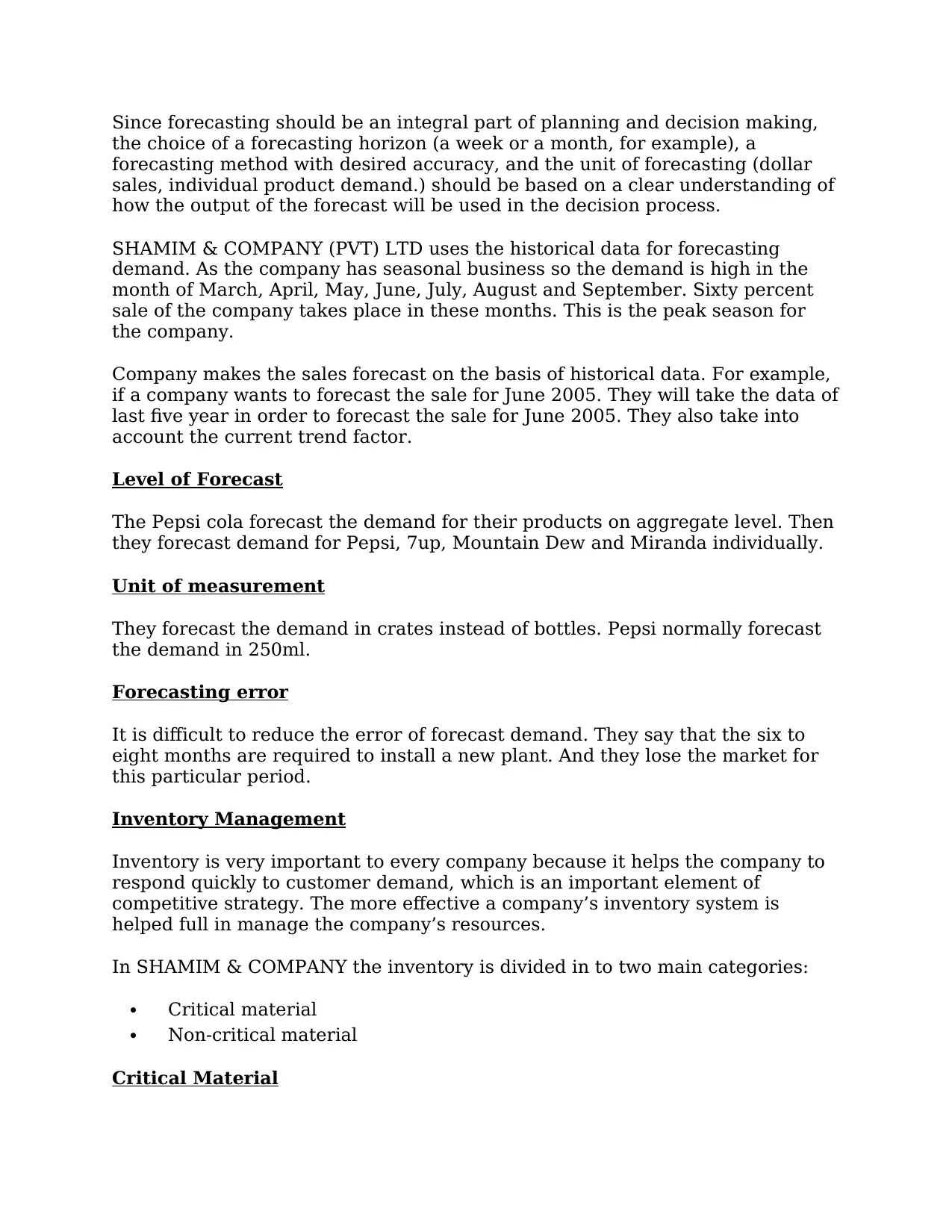
Since forecasting should be an integral part of planning and decision making,
the choice of a forecasting horizon (a week or a month, for example), a
forecasting method with desired accuracy, and the unit of forecasting (dollar
sales, individual product demand.) should be based on a clear understanding of
how the output of the forecast will be used in the decision process.
SHAMIM & COMPANY (PVT) LTD uses the historical data for forecasting
demand. As the company has seasonal business so the demand is high in the
month of March, April, May, June, July, August and September. Sixty percent
sale of the company takes place in these months. This is the peak season for
the company.
Company makes the sales forecast on the basis of historical data. For example,
if a company wants to forecast the sale for June 2005. They will take the data of
last five year in order to forecast the sale for June 2005. They also take into
account the current trend factor.
Level of Forecast
The Pepsi cola forecast the demand for their products on aggregate level. Then
they forecast demand for Pepsi, 7up, Mountain Dew and Miranda individually.
Unit of measurement
They forecast the demand in crates instead of bottles. Pepsi normally forecast
the demand in 250ml.
Forecasting error
It is difficult to reduce the error of forecast demand. They say that the six to
eight months are required to install a new plant. And they lose the market for
this particular period.
Inventory Management
Inventory is very important to every company because it helps the company to
respond quickly to customer demand, which is an important element of
competitive strategy. The more effective a company’s inventory system is
helped full in manage the company’s resources.
In SHAMIM & COMPANY the inventory is divided in to two main categories:
Critical material
Non-critical material
Critical Material
the choice of a forecasting horizon (a week or a month, for example), a
forecasting method with desired accuracy, and the unit of forecasting (dollar
sales, individual product demand.) should be based on a clear understanding of
how the output of the forecast will be used in the decision process.
SHAMIM & COMPANY (PVT) LTD uses the historical data for forecasting
demand. As the company has seasonal business so the demand is high in the
month of March, April, May, June, July, August and September. Sixty percent
sale of the company takes place in these months. This is the peak season for
the company.
Company makes the sales forecast on the basis of historical data. For example,
if a company wants to forecast the sale for June 2005. They will take the data of
last five year in order to forecast the sale for June 2005. They also take into
account the current trend factor.
Level of Forecast
The Pepsi cola forecast the demand for their products on aggregate level. Then
they forecast demand for Pepsi, 7up, Mountain Dew and Miranda individually.
Unit of measurement
They forecast the demand in crates instead of bottles. Pepsi normally forecast
the demand in 250ml.
Forecasting error
It is difficult to reduce the error of forecast demand. They say that the six to
eight months are required to install a new plant. And they lose the market for
this particular period.
Inventory Management
Inventory is very important to every company because it helps the company to
respond quickly to customer demand, which is an important element of
competitive strategy. The more effective a company’s inventory system is
helped full in manage the company’s resources.
In SHAMIM & COMPANY the inventory is divided in to two main categories:
Critical material
Non-critical material
Critical Material
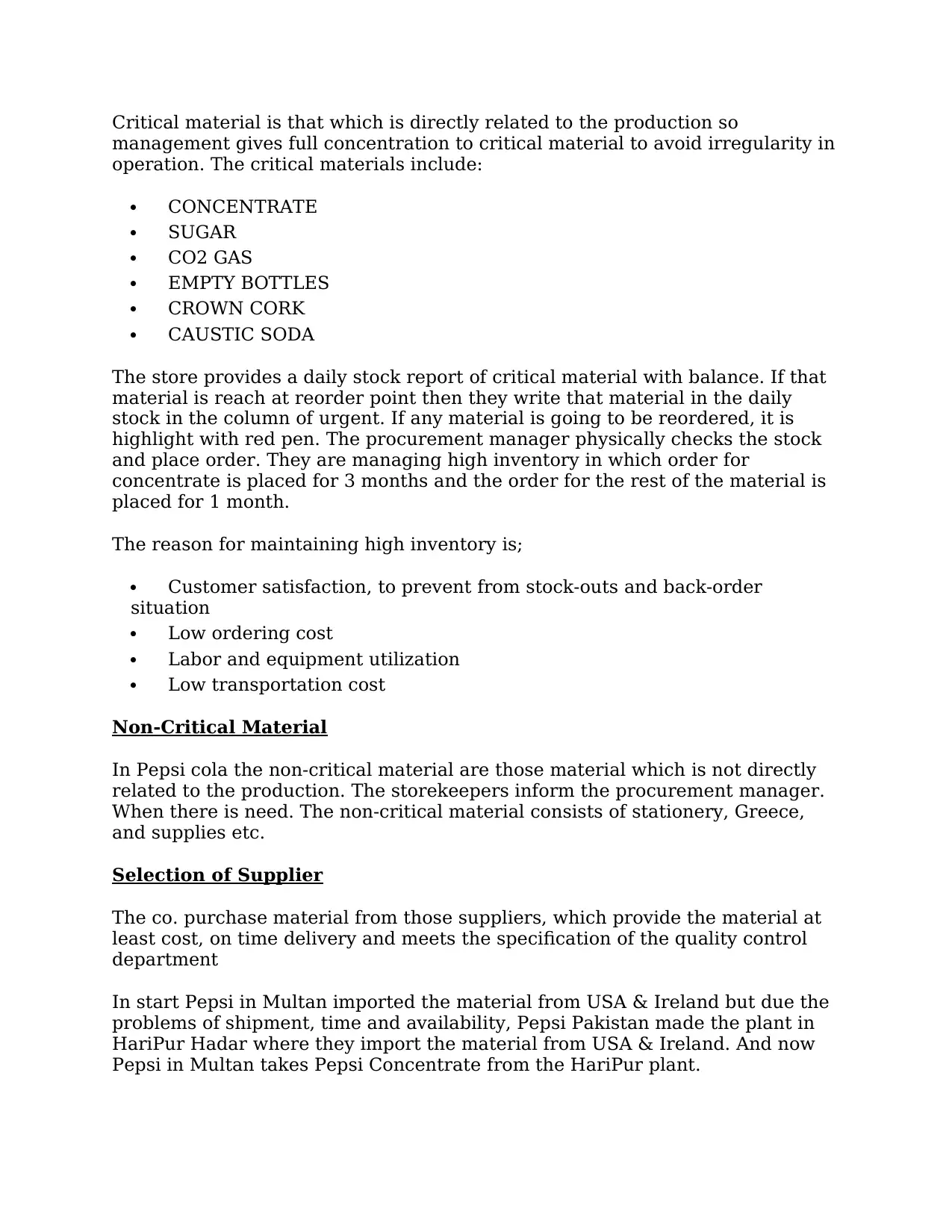
Critical material is that which is directly related to the production so
management gives full concentration to critical material to avoid irregularity in
operation. The critical materials include:
CONCENTRATE
SUGAR
CO2 GAS
EMPTY BOTTLES
CROWN CORK
CAUSTIC SODA
The store provides a daily stock report of critical material with balance. If that
material is reach at reorder point then they write that material in the daily
stock in the column of urgent. If any material is going to be reordered, it is
highlight with red pen. The procurement manager physically checks the stock
and place order. They are managing high inventory in which order for
concentrate is placed for 3 months and the order for the rest of the material is
placed for 1 month.
The reason for maintaining high inventory is;
Customer satisfaction, to prevent from stock-outs and back-order
situation
Low ordering cost
Labor and equipment utilization
Low transportation cost
Non-Critical Material
In Pepsi cola the non-critical material are those material which is not directly
related to the production. The storekeepers inform the procurement manager.
When there is need. The non-critical material consists of stationery, Greece,
and supplies etc.
Selection of Supplier
The co. purchase material from those suppliers, which provide the material at
least cost, on time delivery and meets the specification of the quality control
department
In start Pepsi in Multan imported the material from USA & Ireland but due the
problems of shipment, time and availability, Pepsi Pakistan made the plant in
HariPur Hadar where they import the material from USA & Ireland. And now
Pepsi in Multan takes Pepsi Concentrate from the HariPur plant.
management gives full concentration to critical material to avoid irregularity in
operation. The critical materials include:
CONCENTRATE
SUGAR
CO2 GAS
EMPTY BOTTLES
CROWN CORK
CAUSTIC SODA
The store provides a daily stock report of critical material with balance. If that
material is reach at reorder point then they write that material in the daily
stock in the column of urgent. If any material is going to be reordered, it is
highlight with red pen. The procurement manager physically checks the stock
and place order. They are managing high inventory in which order for
concentrate is placed for 3 months and the order for the rest of the material is
placed for 1 month.
The reason for maintaining high inventory is;
Customer satisfaction, to prevent from stock-outs and back-order
situation
Low ordering cost
Labor and equipment utilization
Low transportation cost
Non-Critical Material
In Pepsi cola the non-critical material are those material which is not directly
related to the production. The storekeepers inform the procurement manager.
When there is need. The non-critical material consists of stationery, Greece,
and supplies etc.
Selection of Supplier
The co. purchase material from those suppliers, which provide the material at
least cost, on time delivery and meets the specification of the quality control
department
In start Pepsi in Multan imported the material from USA & Ireland but due the
problems of shipment, time and availability, Pepsi Pakistan made the plant in
HariPur Hadar where they import the material from USA & Ireland. And now
Pepsi in Multan takes Pepsi Concentrate from the HariPur plant.

Along with the concentrate, Pepsi in Multan also imports the Sugar from
Sheikho Sugar mill & from Shaker Kunj. The bottles are manufactured by Tariq
Glass, Toynasic and BGL under licensed of PEPSI Pakistan. The gases which
are used in PEPSI are made by Multan Factory itself but in case of shortage
Factory buys it from Supreme Gas & Pak Gas. The caps and crowns are
imported from Imran Cork, Mehran – Karachi and Wincloa – Lahore.
Distribution
In Shamim & company, major item of inventory is finished product. There are
two ways to distribute that finish inventory, the first method is direct and
second is indirect method. In direct method they provide crates of bottles to
their dealers at the required destination through their own transport, in
indirect method the dealers have their own transport for distribution.
PEPSI is just one link in a customer value delivery system that includes
thousands of dealers. It is a winner in this part of the world because they have
superior dealer networks. Also the wholesalers and retailers involved are doing
well because PEPSI supplies superior beverages. PEPSI also focuses on
placement of their product such that the consumer can buy a PEPSI from
nearby location. PEPSI also takes immediate action in delivering its products to
market. Overall PEPSI is focusing on fastest delivery and great assortment.
PEPSI Multan is obtaining strong trade cooperation and support from resellers.
The marketing department commands unusual cooperation from resellers
regarding displays, shelf space, promotions and price policies.
Benchmarking
“ The bench marking is a continuous process of comparing a company’s
strategy, products and processes with those of world leaders and in best-in-
class organizations in order to learn how they achieve excellence and then
setting out to match and even surpass it.”
Comparative analysis of Pepsi & Coca-Cola
We will compare these two companies in regard of shares. The shares can be
described in two ways:
Ø Market shares
Ø Volume shares
Market Shares
The market share of a company represents the portion of accounts that the
company holds from the 100% accounts of the market. The market share
Sheikho Sugar mill & from Shaker Kunj. The bottles are manufactured by Tariq
Glass, Toynasic and BGL under licensed of PEPSI Pakistan. The gases which
are used in PEPSI are made by Multan Factory itself but in case of shortage
Factory buys it from Supreme Gas & Pak Gas. The caps and crowns are
imported from Imran Cork, Mehran – Karachi and Wincloa – Lahore.
Distribution
In Shamim & company, major item of inventory is finished product. There are
two ways to distribute that finish inventory, the first method is direct and
second is indirect method. In direct method they provide crates of bottles to
their dealers at the required destination through their own transport, in
indirect method the dealers have their own transport for distribution.
PEPSI is just one link in a customer value delivery system that includes
thousands of dealers. It is a winner in this part of the world because they have
superior dealer networks. Also the wholesalers and retailers involved are doing
well because PEPSI supplies superior beverages. PEPSI also focuses on
placement of their product such that the consumer can buy a PEPSI from
nearby location. PEPSI also takes immediate action in delivering its products to
market. Overall PEPSI is focusing on fastest delivery and great assortment.
PEPSI Multan is obtaining strong trade cooperation and support from resellers.
The marketing department commands unusual cooperation from resellers
regarding displays, shelf space, promotions and price policies.
Benchmarking
“ The bench marking is a continuous process of comparing a company’s
strategy, products and processes with those of world leaders and in best-in-
class organizations in order to learn how they achieve excellence and then
setting out to match and even surpass it.”
Comparative analysis of Pepsi & Coca-Cola
We will compare these two companies in regard of shares. The shares can be
described in two ways:
Ø Market shares
Ø Volume shares
Market Shares
The market share of a company represents the portion of accounts that the
company holds from the 100% accounts of the market. The market share
Paraphrase This Document
Need a fresh take? Get an instant paraphrase of this document with our AI Paraphraser
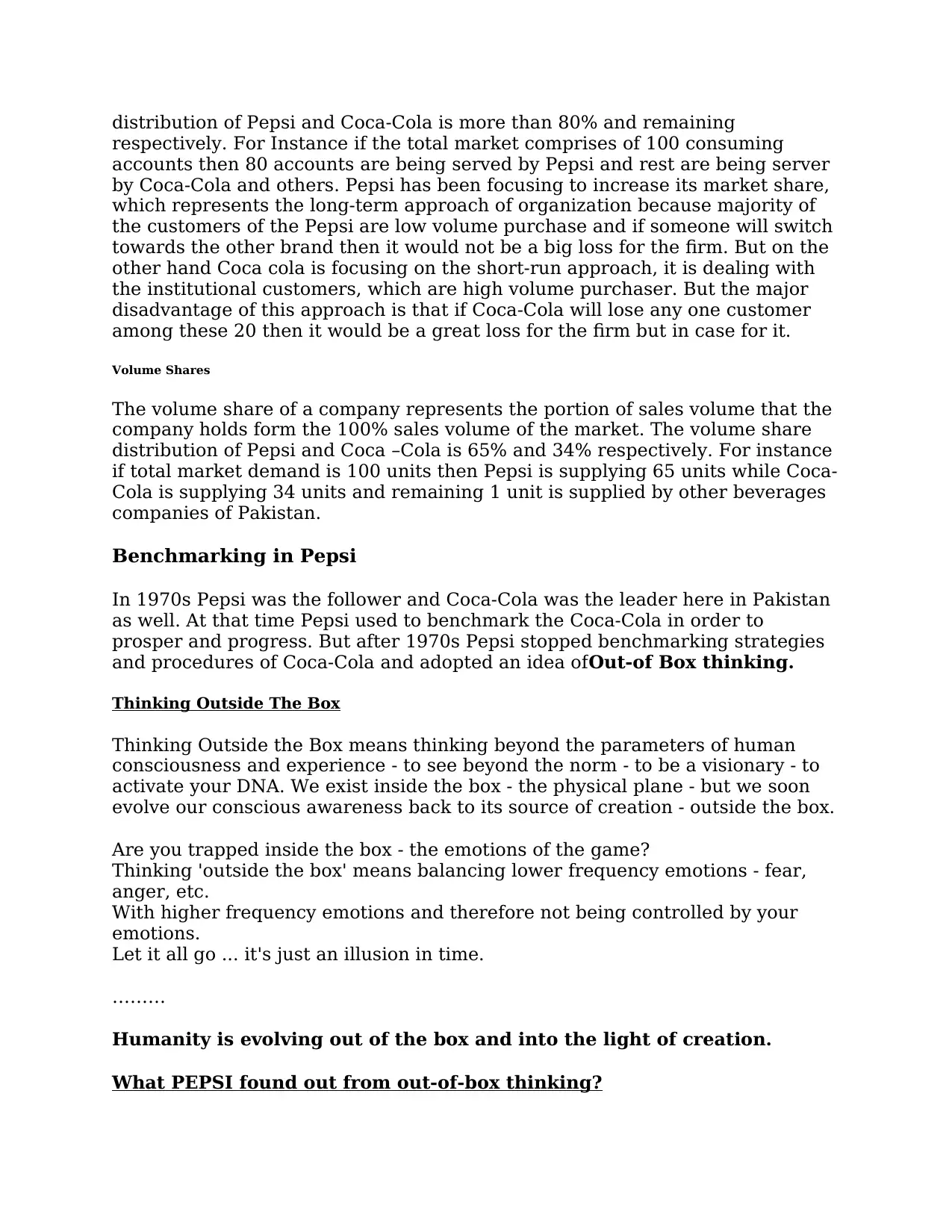
distribution of Pepsi and Coca-Cola is more than 80% and remaining
respectively. For Instance if the total market comprises of 100 consuming
accounts then 80 accounts are being served by Pepsi and rest are being server
by Coca-Cola and others. Pepsi has been focusing to increase its market share,
which represents the long-term approach of organization because majority of
the customers of the Pepsi are low volume purchase and if someone will switch
towards the other brand then it would not be a big loss for the firm. But on the
other hand Coca cola is focusing on the short-run approach, it is dealing with
the institutional customers, which are high volume purchaser. But the major
disadvantage of this approach is that if Coca-Cola will lose any one customer
among these 20 then it would be a great loss for the firm but in case for it.
Volume Shares
The volume share of a company represents the portion of sales volume that the
company holds form the 100% sales volume of the market. The volume share
distribution of Pepsi and Coca –Cola is 65% and 34% respectively. For instance
if total market demand is 100 units then Pepsi is supplying 65 units while Coca-
Cola is supplying 34 units and remaining 1 unit is supplied by other beverages
companies of Pakistan.
Benchmarking in Pepsi
In 1970s Pepsi was the follower and Coca-Cola was the leader here in Pakistan
as well. At that time Pepsi used to benchmark the Coca-Cola in order to
prosper and progress. But after 1970s Pepsi stopped benchmarking strategies
and procedures of Coca-Cola and adopted an idea ofOut-of Box thinking.
Thinking Outside The Box
Thinking Outside the Box means thinking beyond the parameters of human
consciousness and experience - to see beyond the norm - to be a visionary - to
activate your DNA. We exist inside the box - the physical plane - but we soon
evolve our conscious awareness back to its source of creation - outside the box.
Are you trapped inside the box - the emotions of the game?
Thinking 'outside the box' means balancing lower frequency emotions - fear,
anger, etc.
With higher frequency emotions and therefore not being controlled by your
emotions.
Let it all go ... it's just an illusion in time.
………
Humanity is evolving out of the box and into the light of creation.
What PEPSI found out from out-of-box thinking?
respectively. For Instance if the total market comprises of 100 consuming
accounts then 80 accounts are being served by Pepsi and rest are being server
by Coca-Cola and others. Pepsi has been focusing to increase its market share,
which represents the long-term approach of organization because majority of
the customers of the Pepsi are low volume purchase and if someone will switch
towards the other brand then it would not be a big loss for the firm. But on the
other hand Coca cola is focusing on the short-run approach, it is dealing with
the institutional customers, which are high volume purchaser. But the major
disadvantage of this approach is that if Coca-Cola will lose any one customer
among these 20 then it would be a great loss for the firm but in case for it.
Volume Shares
The volume share of a company represents the portion of sales volume that the
company holds form the 100% sales volume of the market. The volume share
distribution of Pepsi and Coca –Cola is 65% and 34% respectively. For instance
if total market demand is 100 units then Pepsi is supplying 65 units while Coca-
Cola is supplying 34 units and remaining 1 unit is supplied by other beverages
companies of Pakistan.
Benchmarking in Pepsi
In 1970s Pepsi was the follower and Coca-Cola was the leader here in Pakistan
as well. At that time Pepsi used to benchmark the Coca-Cola in order to
prosper and progress. But after 1970s Pepsi stopped benchmarking strategies
and procedures of Coca-Cola and adopted an idea ofOut-of Box thinking.
Thinking Outside The Box
Thinking Outside the Box means thinking beyond the parameters of human
consciousness and experience - to see beyond the norm - to be a visionary - to
activate your DNA. We exist inside the box - the physical plane - but we soon
evolve our conscious awareness back to its source of creation - outside the box.
Are you trapped inside the box - the emotions of the game?
Thinking 'outside the box' means balancing lower frequency emotions - fear,
anger, etc.
With higher frequency emotions and therefore not being controlled by your
emotions.
Let it all go ... it's just an illusion in time.
………
Humanity is evolving out of the box and into the light of creation.
What PEPSI found out from out-of-box thinking?
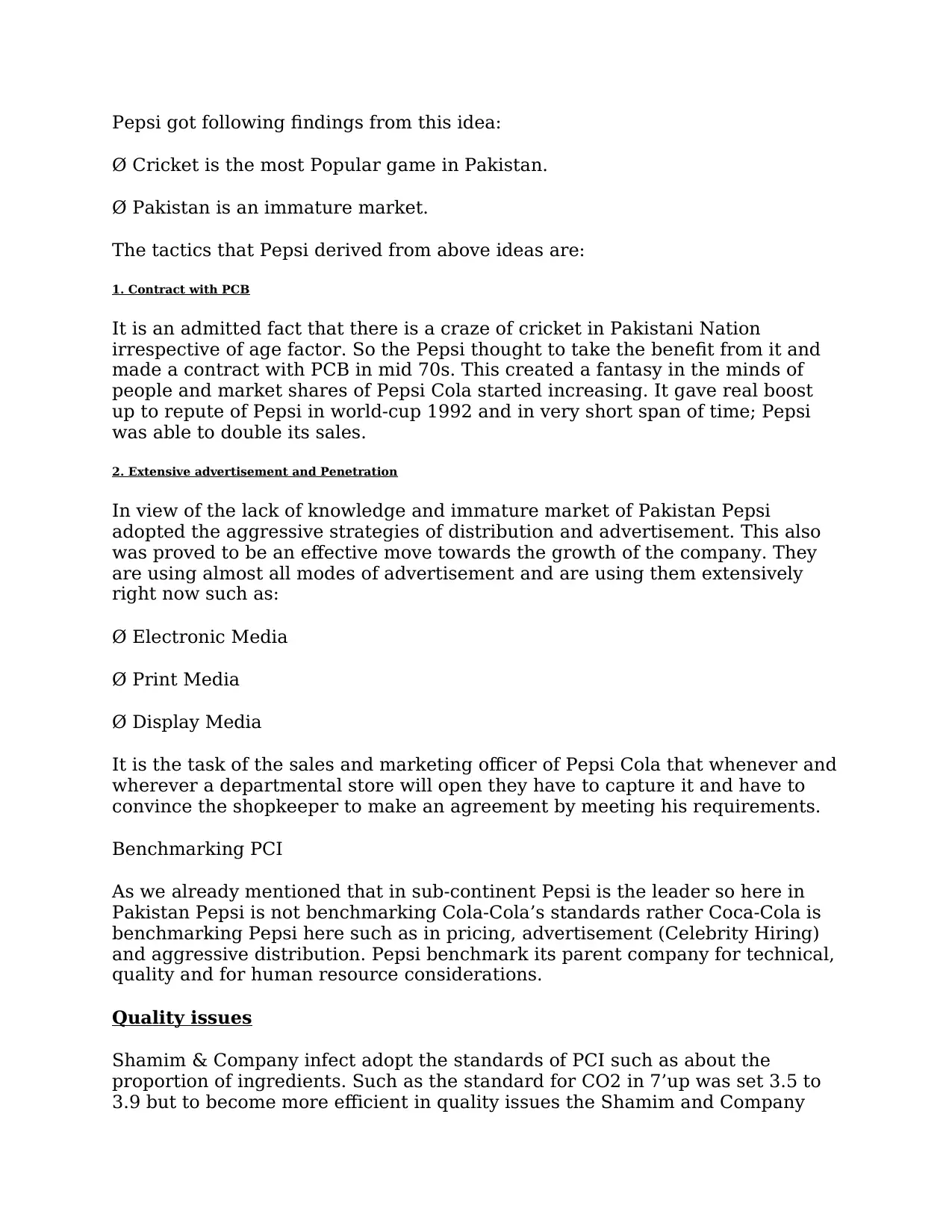
Pepsi got following findings from this idea:
Ø Cricket is the most Popular game in Pakistan.
Ø Pakistan is an immature market.
The tactics that Pepsi derived from above ideas are:
1. Contract with PCB
It is an admitted fact that there is a craze of cricket in Pakistani Nation
irrespective of age factor. So the Pepsi thought to take the benefit from it and
made a contract with PCB in mid 70s. This created a fantasy in the minds of
people and market shares of Pepsi Cola started increasing. It gave real boost
up to repute of Pepsi in world-cup 1992 and in very short span of time; Pepsi
was able to double its sales.
2. Extensive advertisement and Penetration
In view of the lack of knowledge and immature market of Pakistan Pepsi
adopted the aggressive strategies of distribution and advertisement. This also
was proved to be an effective move towards the growth of the company. They
are using almost all modes of advertisement and are using them extensively
right now such as:
Ø Electronic Media
Ø Print Media
Ø Display Media
It is the task of the sales and marketing officer of Pepsi Cola that whenever and
wherever a departmental store will open they have to capture it and have to
convince the shopkeeper to make an agreement by meeting his requirements.
Benchmarking PCI
As we already mentioned that in sub-continent Pepsi is the leader so here in
Pakistan Pepsi is not benchmarking Cola-Cola’s standards rather Coca-Cola is
benchmarking Pepsi here such as in pricing, advertisement (Celebrity Hiring)
and aggressive distribution. Pepsi benchmark its parent company for technical,
quality and for human resource considerations.
Quality issues
Shamim & Company infect adopt the standards of PCI such as about the
proportion of ingredients. Such as the standard for CO2 in 7’up was set 3.5 to
3.9 but to become more efficient in quality issues the Shamim and Company
Ø Cricket is the most Popular game in Pakistan.
Ø Pakistan is an immature market.
The tactics that Pepsi derived from above ideas are:
1. Contract with PCB
It is an admitted fact that there is a craze of cricket in Pakistani Nation
irrespective of age factor. So the Pepsi thought to take the benefit from it and
made a contract with PCB in mid 70s. This created a fantasy in the minds of
people and market shares of Pepsi Cola started increasing. It gave real boost
up to repute of Pepsi in world-cup 1992 and in very short span of time; Pepsi
was able to double its sales.
2. Extensive advertisement and Penetration
In view of the lack of knowledge and immature market of Pakistan Pepsi
adopted the aggressive strategies of distribution and advertisement. This also
was proved to be an effective move towards the growth of the company. They
are using almost all modes of advertisement and are using them extensively
right now such as:
Ø Electronic Media
Ø Print Media
Ø Display Media
It is the task of the sales and marketing officer of Pepsi Cola that whenever and
wherever a departmental store will open they have to capture it and have to
convince the shopkeeper to make an agreement by meeting his requirements.
Benchmarking PCI
As we already mentioned that in sub-continent Pepsi is the leader so here in
Pakistan Pepsi is not benchmarking Cola-Cola’s standards rather Coca-Cola is
benchmarking Pepsi here such as in pricing, advertisement (Celebrity Hiring)
and aggressive distribution. Pepsi benchmark its parent company for technical,
quality and for human resource considerations.
Quality issues
Shamim & Company infect adopt the standards of PCI such as about the
proportion of ingredients. Such as the standard for CO2 in 7’up was set 3.5 to
3.9 but to become more efficient in quality issues the Shamim and Company

redefined it as 3.6 to 3.8. However the ideal standard for CO2 is 3.7. Similarly
for the Marinda they refined the standard for getting much and much closer to
the ideal standard.
Technology
Pepsi in Pakistan always benchmarks its parent Company for the sake of
technology improvement. For instance they are going to start a new plant in
Lahore, which would have the capacity to fulfill the total demand of Lahore
district. And it would require only 3 operatives to operate this plant.
Celebrity Hiring:
In our culture cricketers and film stars have much influence on people. Pepsi is
using both the vehicles to advertise its brands. It has established the contract
with prominent film star Reema as a brand representative for Pepsi. Similarly
contracts have been established with Inzamam-ul-Haq and other cricketers.
Employee policies
Earlier Pepsi was not focusing too much on employee’s benefits and facilities.
Then it adopted the idea that “result and rewards have a positive co-relation.”
Shamim & Company took this idea from PCI that if employees and satisfied and
motivated towards the achievement of the Goals only then organization can
better grow. In early 90s Pepsi adopted a new benefit plan for its employees
and management. Now in employee in the marketing department has a car,
having the medical facilities, insurance and a good compensation. So these
policies regarding the employees helped the organization to achieve its target
related to sales, growth and image of highly committed organization.
Collecting Feedback from customers
Actually, Pepsi is using two ways to collect the feedback from its customers.
Ø Direct Method
Ø Indirect Method
Direct Method
In direct method they collect feedback from its distributors, business
customers and retailers about demand, market situation, consumer behavior
and on other issues through its Sales Information System (SIS). For example
they take vehicle plan from the distributors.
And Pepsi measures the performance of its distributors and other customers
through collecting the data about
for the Marinda they refined the standard for getting much and much closer to
the ideal standard.
Technology
Pepsi in Pakistan always benchmarks its parent Company for the sake of
technology improvement. For instance they are going to start a new plant in
Lahore, which would have the capacity to fulfill the total demand of Lahore
district. And it would require only 3 operatives to operate this plant.
Celebrity Hiring:
In our culture cricketers and film stars have much influence on people. Pepsi is
using both the vehicles to advertise its brands. It has established the contract
with prominent film star Reema as a brand representative for Pepsi. Similarly
contracts have been established with Inzamam-ul-Haq and other cricketers.
Employee policies
Earlier Pepsi was not focusing too much on employee’s benefits and facilities.
Then it adopted the idea that “result and rewards have a positive co-relation.”
Shamim & Company took this idea from PCI that if employees and satisfied and
motivated towards the achievement of the Goals only then organization can
better grow. In early 90s Pepsi adopted a new benefit plan for its employees
and management. Now in employee in the marketing department has a car,
having the medical facilities, insurance and a good compensation. So these
policies regarding the employees helped the organization to achieve its target
related to sales, growth and image of highly committed organization.
Collecting Feedback from customers
Actually, Pepsi is using two ways to collect the feedback from its customers.
Ø Direct Method
Ø Indirect Method
Direct Method
In direct method they collect feedback from its distributors, business
customers and retailers about demand, market situation, consumer behavior
and on other issues through its Sales Information System (SIS). For example
they take vehicle plan from the distributors.
And Pepsi measures the performance of its distributors and other customers
through collecting the data about
1 out of 22
Related Documents
Your All-in-One AI-Powered Toolkit for Academic Success.
+13062052269
info@desklib.com
Available 24*7 on WhatsApp / Email
![[object Object]](/_next/static/media/star-bottom.7253800d.svg)
Unlock your academic potential
© 2024 | Zucol Services PVT LTD | All rights reserved.




